RAF Gan 1958 and Later
Thank you for this enjoyable thread, Warmtoast. I'm glad that the unloading of stores got well sorted, especially of the Tennents Lager that it was the task of crews in the Transit Crew Mess to do their best to exhaust. Years of collecting Cigarette Cards and Stamps came into there own in the challenge of building a complete set of the Tennents Girls among the empty cans:-
Tennents Girls
Tennents Girls
Fantastic thread warmtoast, keep those photographs and memories coming.
MPN11. The three landing craft that were plodding the lagoon in 67/68 were NOT the type shown in the link. I was a Hitaddo hermit at the time and spent quite a bit of time on them.
For those interested Google raf gan remembered.
Thanks Warm toast.
MPN11. The three landing craft that were plodding the lagoon in 67/68 were NOT the type shown in the link. I was a Hitaddo hermit at the time and spent quite a bit of time on them.
For those interested Google raf gan remembered.
Thanks Warm toast.
Join Date: Mar 2007
Location: England
Posts: 39
Likes: 0
Received 0 Likes
on
0 Posts
Great Thread, Warmtoast. I was there for 9 months @1973-4. Your early pics are terrific. For anyone interested, Peter Doling has written a very full and complete history of g
an called "From Port T to RAF Gan".
an called "From Port T to RAF Gan".
Join Date: Mar 2010
Location: Often in Jersey, but mainly in the past.
Age: 79
Posts: 7,808
Received 135 Likes
on
63 Posts
Mickj3 ... Defer to your personal experience, but I have never heard the term "Landing Craft Men". Nor has Wikipedia >>> https://en.wikipedia.org/wiki/Landing_craft
Not worth chewing our gums over, though.
Not worth chewing our gums over, though.
There's just been a very brief glimpse of Gan on BBC4 (Britain's Treasure Islands).
Not too sure why he sailed 3 days from Malé, I thought the airport was still operating.
Not too sure why he sailed 3 days from Malé, I thought the airport was still operating.
Thread Starter
Continued - Part 5
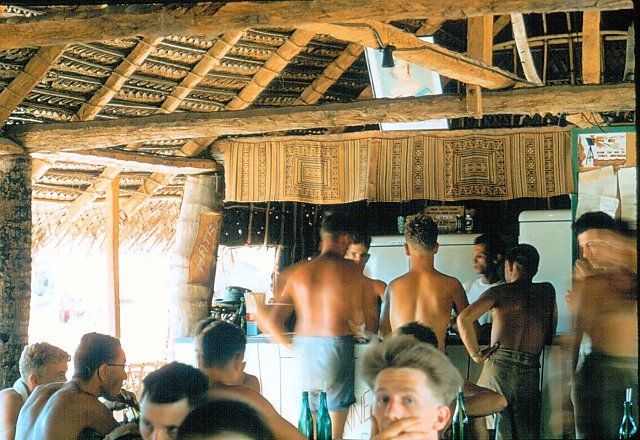
The Mess doubled as the NAAFI in the evening whilst the “Astra” Cinema was outside. If it rained we got wet! The only beer we had was a Dutch brew "Pegasus", it was OK, but don't recollect having drunk it after leaving Gan.
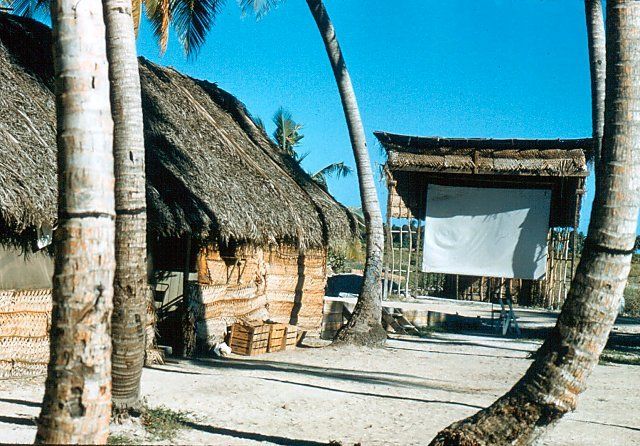
The outside cinema. Films were flown in from Katunayake (Negombo) regularly, there was no charge, just drag a chair out from the mess, bring a waterproof ground sheet to cover yourself in case it rained, wear "mossie" boots, long sleeve shirt and long trousers to protect oneself from the ferocious mosquitos and enjoy the show.
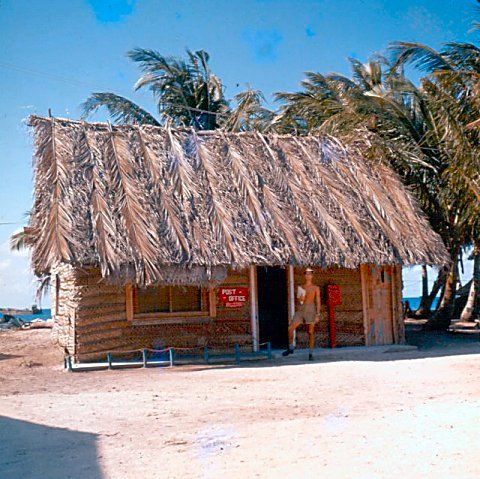
Bizarrely for the first few months mail for Gan was routed through the Ceylon postal system. This meant we had to pay Ceylon customs duty for any parcels or items of value received from home. Things improved when a British Forces Post Office was established (BFPO 180), and mail was received direct from London without Ceylon being involved in the process. The “Postmaster” was a tall Army (Royal Engineers) corporal who we nicknamed “Lofty”. He’s seen here in front of his post office.
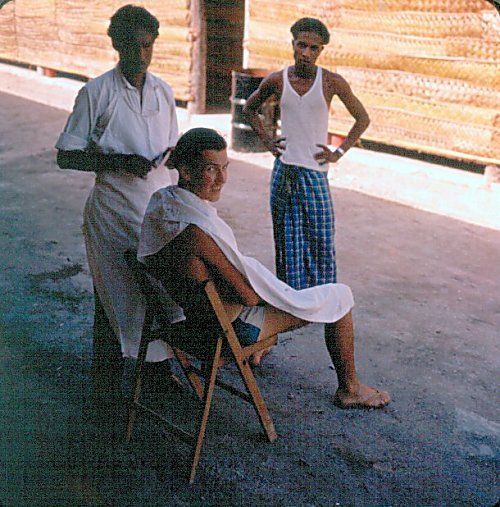
There was no hairdresser on Gan, but an enterprising Maldivian turned out to be adept as a barber as seen here.

After a month or two living accommodation improved and basic Kadjan-walled blocks were built. They were simple and effective. Lay a concrete base with palm tree trunk uprights set into the concrete to support the corrugated iron roof. Fix joists and bearers across the uprights and fix woven kadjan palm leaves onto the bearers to hang down as walls. They were enormously hot during the day with the heat of the sun radiating off the bare corrugated iron roof (which made a terrible din when it rained), but it was luxury compared to living in a brown tent.
The Visit of Dr Hans Hass in his Schooner "Xarifa"

When we heard on the grapevine that the renowned diver and oceanographer Dr Hans Hass and his schooner Xarifa was to visit Gan some of the young airmen who hadn’t seen a white woman for months were all agog, mainly because they hoped to catch sight of Lotte, Hans’ glamorous and eye-catching young wife, but unfortunately (for us) she was at home in Vienna having just given birth to their first child together, a girl called Meta (Lotte was his second wife; Hans already had a son by his first wife Hannelore).
Anyway Hans Hass had organised an underwater filming expedition to the Maldives aboard his schooner Xarifa. He made two visits to Gan. On his first he anchored off Gan in Addu Atoll on 21st December 1957 and departed on 27th December 1957. His second visit took place from the 3rd to 8th of February 1958 whilst I was there. During his second visit to Gan he came ashore to talk to an attentive RAF audience about reef diving as can be seen in the photo below.
The result of his filming expedition was 26 30-minute episodes about the underwater life of the Indian Ocean including the Atolls of the Maldives “Travellers Tales: The Undersea World of Adventure” was first shown on the BBC and then on TV around the world between 1959 and 1962.
He later published a book about his Maldives expedition titled “Expedition into the Unknown” (Published by Hutchinson).
On 8th February 1958 he departed north to film further reefs and atolls in the Maldives and afterwards travelled east to dive on the Nicobar Islands, but after difficulties with the Indian authorities (the Indians kept the Nicobar Islands strictly off-limits to foreigners) he went on to Singapore.
Dr Hass arrived in Singapore in October 1958, where he left Xarifa in the care of 37 Water Transport Company of the Royal Army Service Corps (for two years!).
After nine years (1951—1960) as the focal point of his tropical marine research and exploration, Xarifa was sold by Dr Hass in Singapore to an Italian industrialist and it was sailed back to Europe. The vessel is still around, home port Monaco, where she leads the life of a luxury yacht (see below).

February 1958: Dr Hans Hass talking diving to an attentive RAF Gan audience. On Professor Hass’ immediate right is Mr Alex Smith (Air Ministry Works Department) and next to him S/Ldr Roy A Schofield, Commanding Officer RAF Gan 1957 to early 1958.
Below
Contemporary photos of Hans and Lotte on the Xarifa and being interviewed by the BBC.
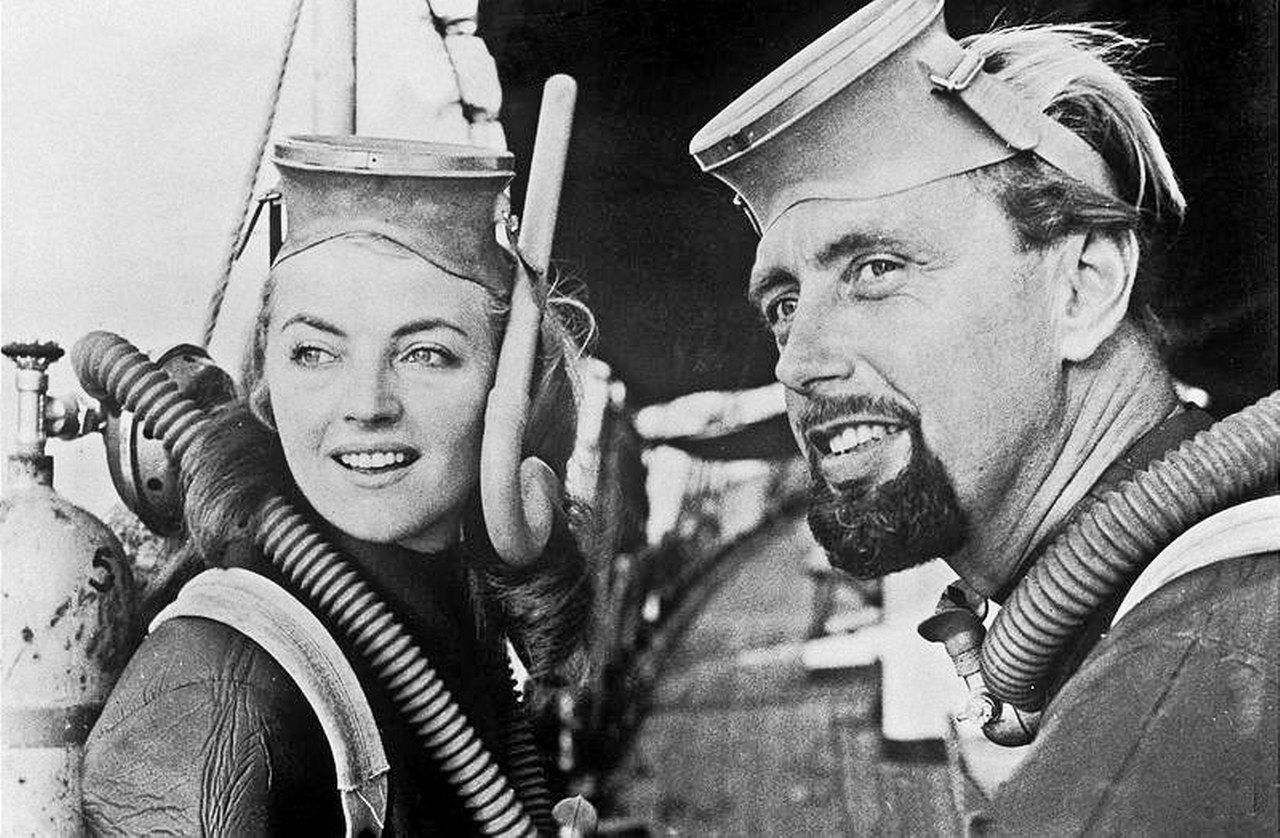
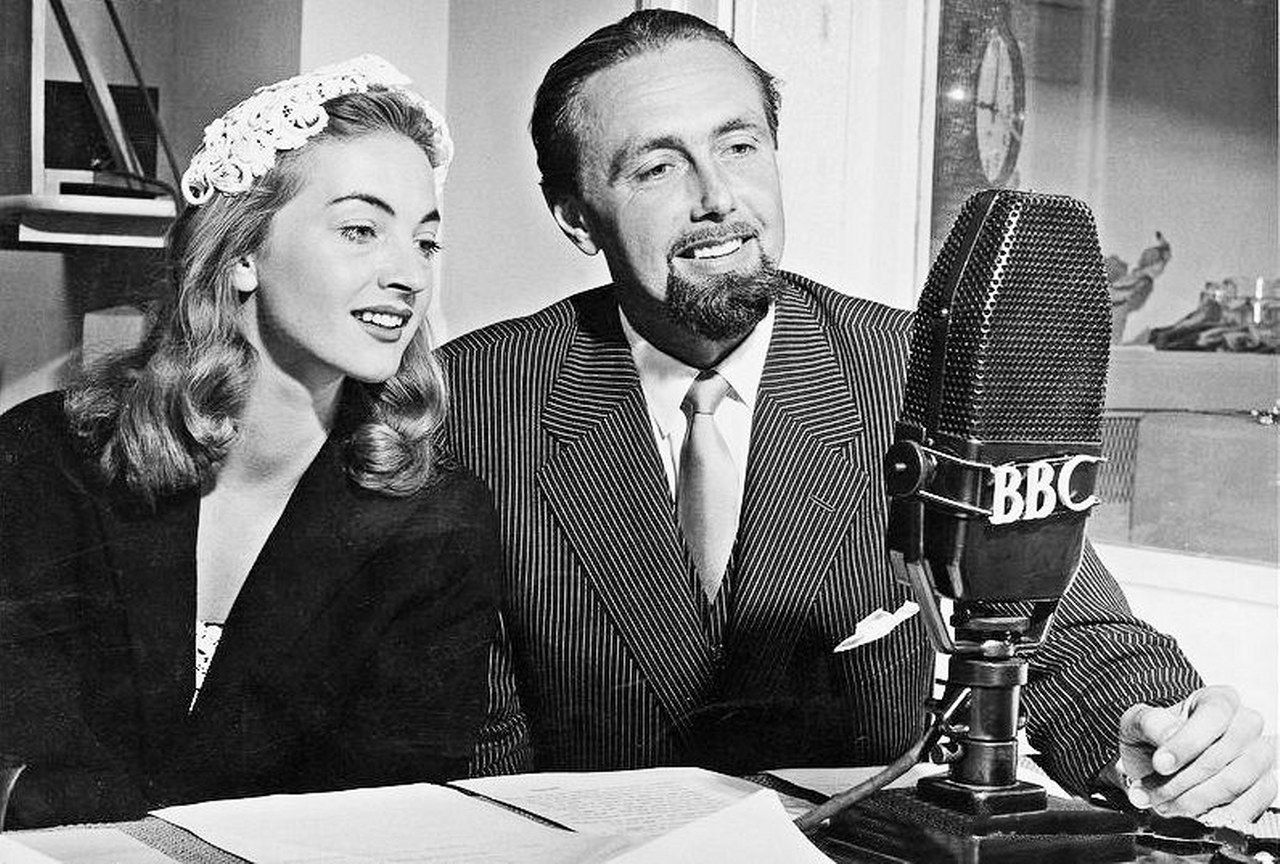
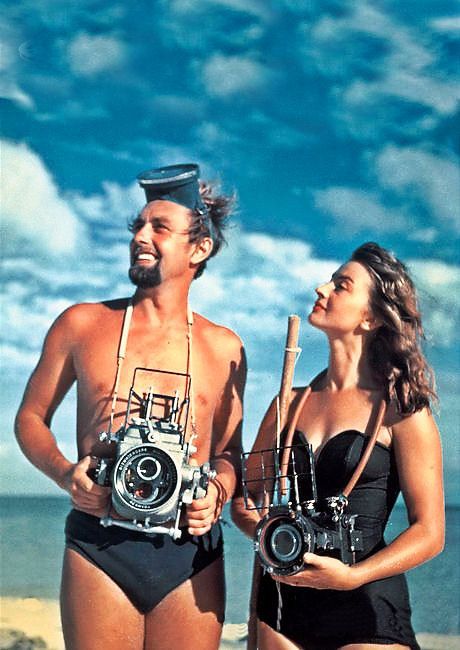
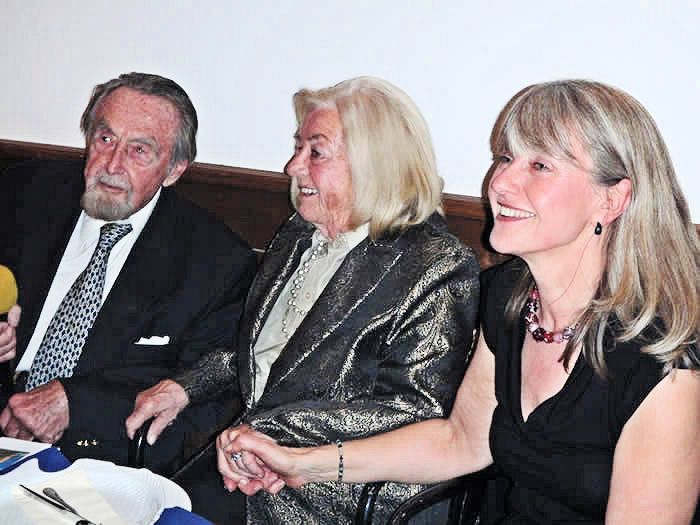
Dr Hans Hass died in Vienna on 16th June 2013 aged 94. His second wife Lotte died on 15th January 2015 age 86.
They are shown here with daughter Meta (Hass-Raunig) whose birth in Vienna in 1957/58 was the reason why Lotte wasn’t with Hans during his visit to Gan.
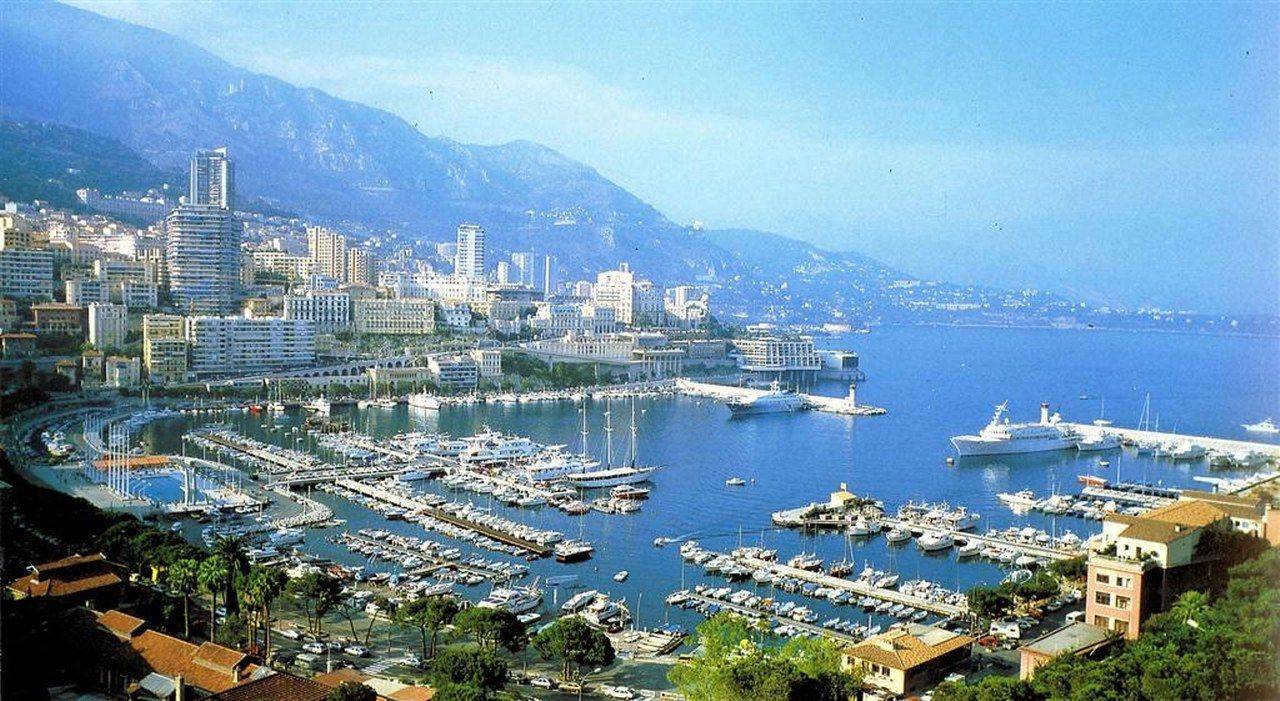
In 2006 I was in Monaco on business to check my off-shore accounts (I wish!) and had to see what Xarifa looked like nearly fifty years on — she’s the three-masted yacht in the centre of Monaco harbour (above). In 2006 she looked in considerably better shape than I remember her at Gan in 1958!
Photos taken in Monaco in 2006 below.
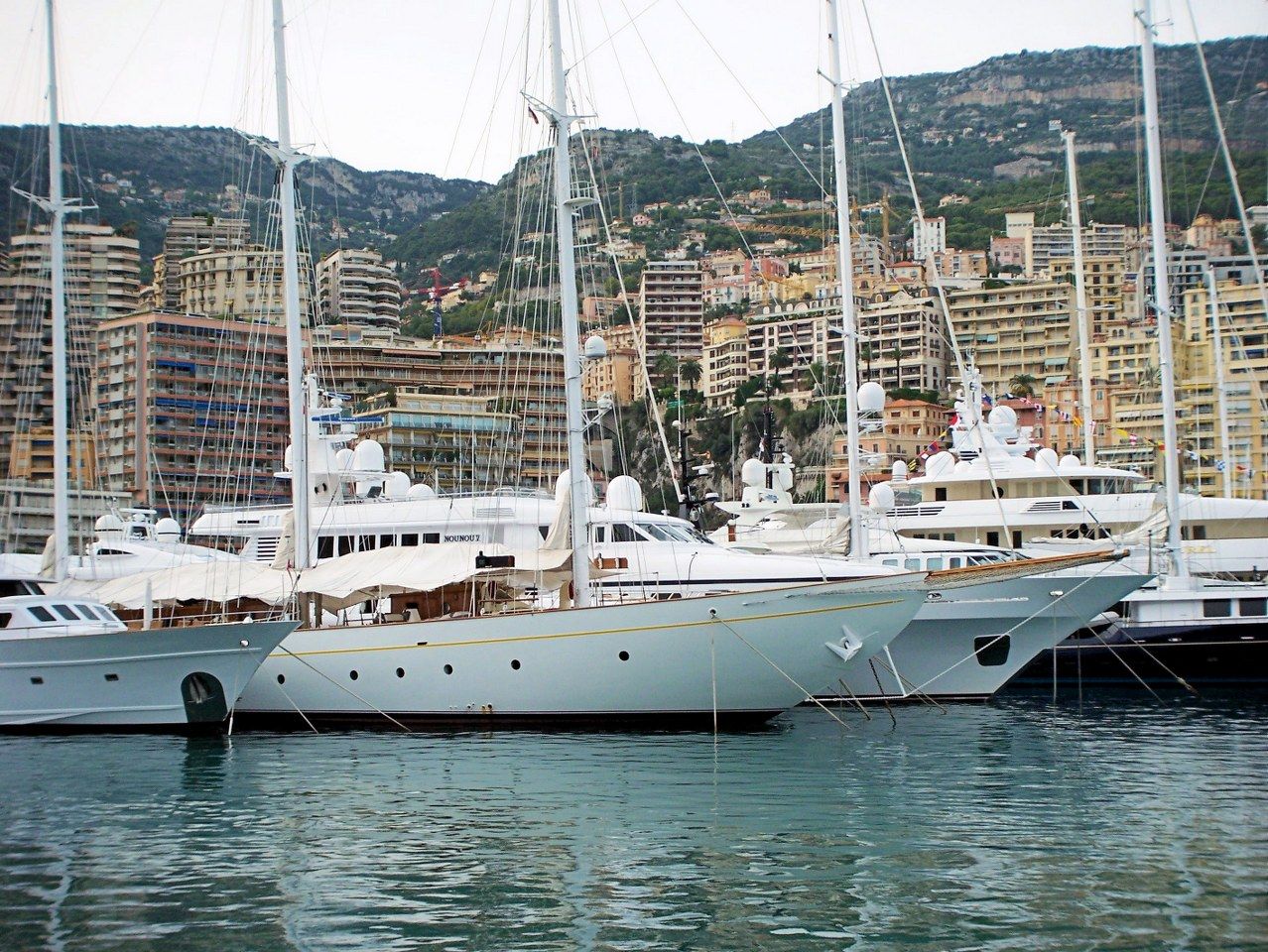
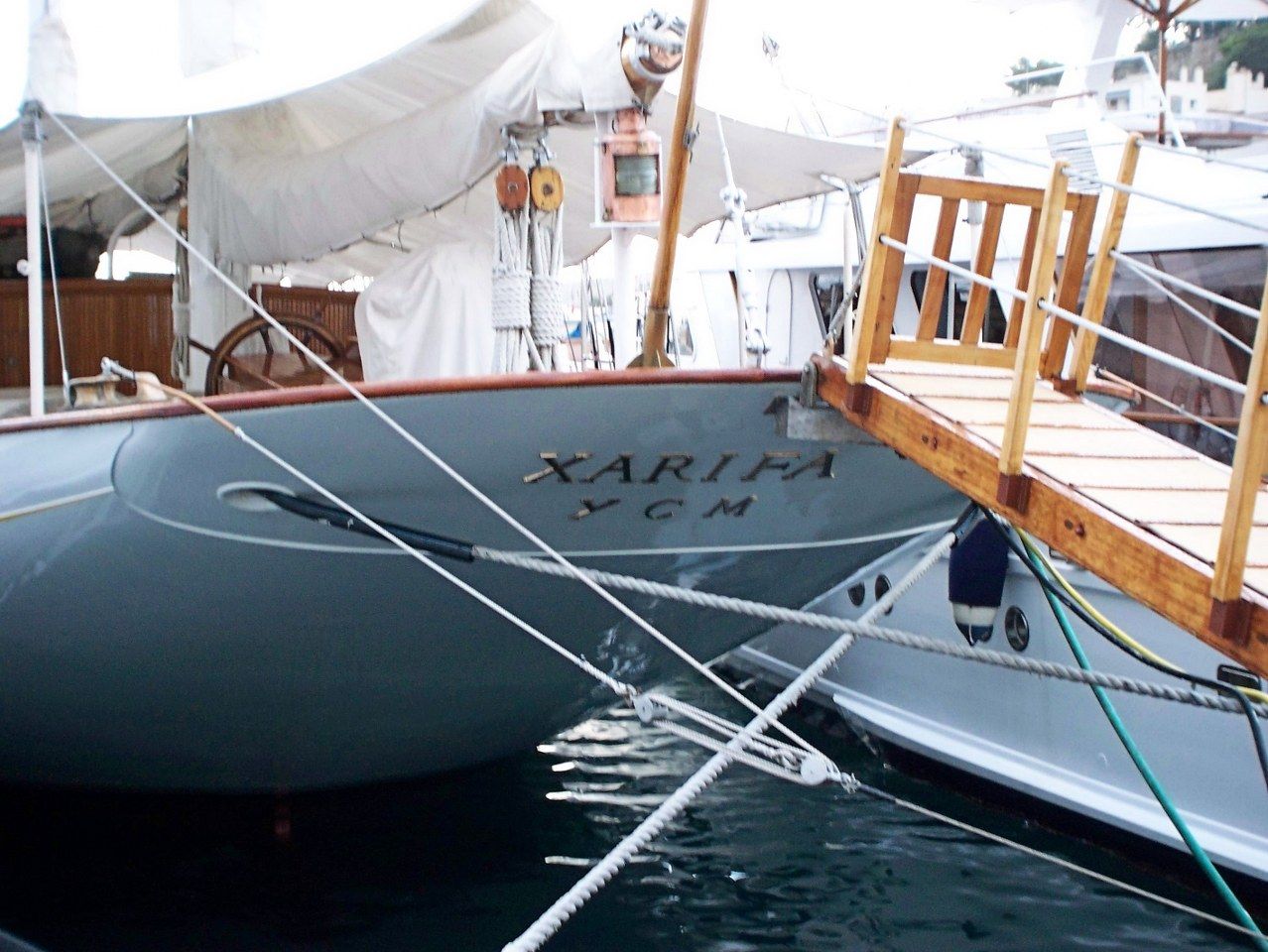
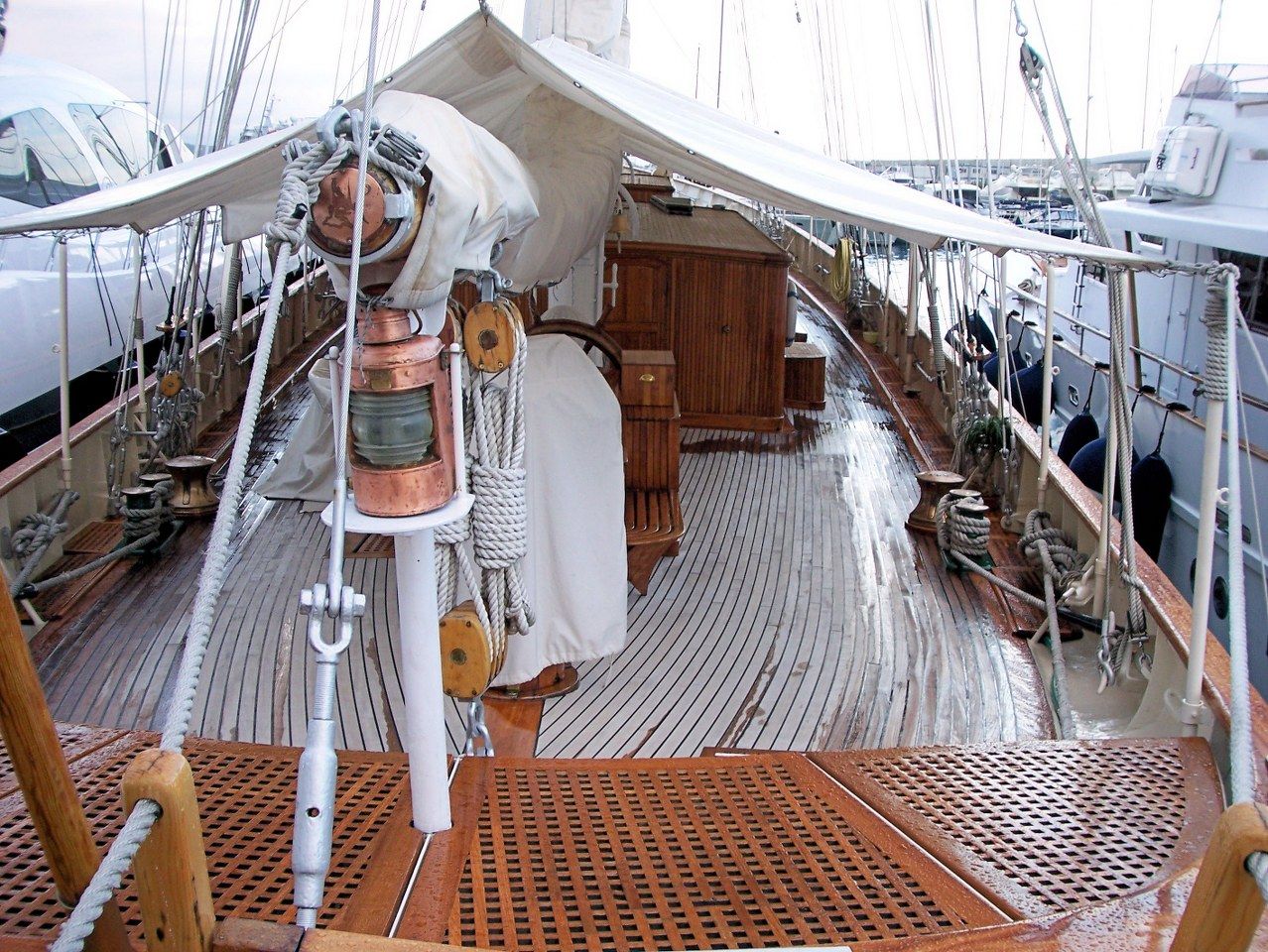
With a millionaire owner and based in Monaco "Xarifa" was in remarkably good shape for a schooner that was originally owned by the heir to the Singer Sewing Machine fortune and later before being bought by Hans Hass served as a coal transporter in Canada during the war ISTR.
More to come
WT

The Mess doubled as the NAAFI in the evening whilst the “Astra” Cinema was outside. If it rained we got wet! The only beer we had was a Dutch brew "Pegasus", it was OK, but don't recollect having drunk it after leaving Gan.

The outside cinema. Films were flown in from Katunayake (Negombo) regularly, there was no charge, just drag a chair out from the mess, bring a waterproof ground sheet to cover yourself in case it rained, wear "mossie" boots, long sleeve shirt and long trousers to protect oneself from the ferocious mosquitos and enjoy the show.

Bizarrely for the first few months mail for Gan was routed through the Ceylon postal system. This meant we had to pay Ceylon customs duty for any parcels or items of value received from home. Things improved when a British Forces Post Office was established (BFPO 180), and mail was received direct from London without Ceylon being involved in the process. The “Postmaster” was a tall Army (Royal Engineers) corporal who we nicknamed “Lofty”. He’s seen here in front of his post office.

There was no hairdresser on Gan, but an enterprising Maldivian turned out to be adept as a barber as seen here.

After a month or two living accommodation improved and basic Kadjan-walled blocks were built. They were simple and effective. Lay a concrete base with palm tree trunk uprights set into the concrete to support the corrugated iron roof. Fix joists and bearers across the uprights and fix woven kadjan palm leaves onto the bearers to hang down as walls. They were enormously hot during the day with the heat of the sun radiating off the bare corrugated iron roof (which made a terrible din when it rained), but it was luxury compared to living in a brown tent.
The Visit of Dr Hans Hass in his Schooner "Xarifa"

When we heard on the grapevine that the renowned diver and oceanographer Dr Hans Hass and his schooner Xarifa was to visit Gan some of the young airmen who hadn’t seen a white woman for months were all agog, mainly because they hoped to catch sight of Lotte, Hans’ glamorous and eye-catching young wife, but unfortunately (for us) she was at home in Vienna having just given birth to their first child together, a girl called Meta (Lotte was his second wife; Hans already had a son by his first wife Hannelore).
Anyway Hans Hass had organised an underwater filming expedition to the Maldives aboard his schooner Xarifa. He made two visits to Gan. On his first he anchored off Gan in Addu Atoll on 21st December 1957 and departed on 27th December 1957. His second visit took place from the 3rd to 8th of February 1958 whilst I was there. During his second visit to Gan he came ashore to talk to an attentive RAF audience about reef diving as can be seen in the photo below.
The result of his filming expedition was 26 30-minute episodes about the underwater life of the Indian Ocean including the Atolls of the Maldives “Travellers Tales: The Undersea World of Adventure” was first shown on the BBC and then on TV around the world between 1959 and 1962.
He later published a book about his Maldives expedition titled “Expedition into the Unknown” (Published by Hutchinson).
On 8th February 1958 he departed north to film further reefs and atolls in the Maldives and afterwards travelled east to dive on the Nicobar Islands, but after difficulties with the Indian authorities (the Indians kept the Nicobar Islands strictly off-limits to foreigners) he went on to Singapore.
Dr Hass arrived in Singapore in October 1958, where he left Xarifa in the care of 37 Water Transport Company of the Royal Army Service Corps (for two years!).
After nine years (1951—1960) as the focal point of his tropical marine research and exploration, Xarifa was sold by Dr Hass in Singapore to an Italian industrialist and it was sailed back to Europe. The vessel is still around, home port Monaco, where she leads the life of a luxury yacht (see below).

February 1958: Dr Hans Hass talking diving to an attentive RAF Gan audience. On Professor Hass’ immediate right is Mr Alex Smith (Air Ministry Works Department) and next to him S/Ldr Roy A Schofield, Commanding Officer RAF Gan 1957 to early 1958.
Below
Contemporary photos of Hans and Lotte on the Xarifa and being interviewed by the BBC.




Dr Hans Hass died in Vienna on 16th June 2013 aged 94. His second wife Lotte died on 15th January 2015 age 86.
They are shown here with daughter Meta (Hass-Raunig) whose birth in Vienna in 1957/58 was the reason why Lotte wasn’t with Hans during his visit to Gan.

In 2006 I was in Monaco on business to check my off-shore accounts (I wish!) and had to see what Xarifa looked like nearly fifty years on — she’s the three-masted yacht in the centre of Monaco harbour (above). In 2006 she looked in considerably better shape than I remember her at Gan in 1958!
Photos taken in Monaco in 2006 below.



With a millionaire owner and based in Monaco "Xarifa" was in remarkably good shape for a schooner that was originally owned by the heir to the Singer Sewing Machine fortune and later before being bought by Hans Hass served as a coal transporter in Canada during the war ISTR.
More to come
WT
Last edited by Warmtoast; 13th Apr 2016 at 20:56.
Guest
Posts: n/a
Warmtoast,
What a superb photographic record of the early days of the RAF's settlement in Gan ! I've been neglecting this Thread recently in efforts to get on top of the backlog of Posts on "Pilot's Brevet" but now intend to give it the full and undivided attention which it so richly deserves.
First shot out of the locker: what interesting diagrams you show (in your #2) of the "Empire" Air Routes in 1950 and 1960. The importance of Gan sticks out "like a sore thumb" in the 1960 drawing, and it illustrates that Gan was the most southerly of a chain of Indian Ocean islands with the Laccadives at the northern end. As I've said, the Indian Government Tourist Board seems to have been very slow to see the potential of the Laccadives as a tourist destination to compete with the Maldives. But they have an airstrip there now and a resort infrastructure could easily be served by sea from Cochin or Calicut.
And it would be a welcome change from places like Goa, which, by all accounts, has become a sort of Benidorm-sur-Malabar. And nothing can equal the glorious tropical sunsets out over the Arabian Sea and the Indian Ocean. Did you ever see the famed "green flash" at sundown, btw ?
Danny.
What a superb photographic record of the early days of the RAF's settlement in Gan ! I've been neglecting this Thread recently in efforts to get on top of the backlog of Posts on "Pilot's Brevet" but now intend to give it the full and undivided attention which it so richly deserves.
First shot out of the locker: what interesting diagrams you show (in your #2) of the "Empire" Air Routes in 1950 and 1960. The importance of Gan sticks out "like a sore thumb" in the 1960 drawing, and it illustrates that Gan was the most southerly of a chain of Indian Ocean islands with the Laccadives at the northern end. As I've said, the Indian Government Tourist Board seems to have been very slow to see the potential of the Laccadives as a tourist destination to compete with the Maldives. But they have an airstrip there now and a resort infrastructure could easily be served by sea from Cochin or Calicut.
And it would be a welcome change from places like Goa, which, by all accounts, has become a sort of Benidorm-sur-Malabar. And nothing can equal the glorious tropical sunsets out over the Arabian Sea and the Indian Ocean. Did you ever see the famed "green flash" at sundown, btw ?
Danny.
Thread Starter
Danny42C
Sorry, it doesn't ring a bell with me and I don't recall any green flashes at sundown at Gan.
As regards Indian Ocean airstrips the Nicobar Islands has/had an airstrip at Car Nicobar. Car Nic was a regular refuelling stop for the Changi-based 'Pigs' (Valettas) and RNZAF Bristol Freighters employed on the regular Changi – Negombo (Katunayake, Sri Lanka) run. They routed Changi – RAAF Butterworth (Penang) – Car Nicobar – Negombo, and later when the crushed coral runway had been constructed at Gan, continued down there as part of the Negombo – Gan airbridge, when the frequency was upped to three a week.
I went through Car Nic a few times in 1956 – 1958, refuelling was done by the locally-based Indian Air Force personnel. There was no terminal as such and on arrival pax disembarked and just hung around the aircraft to stretch their legs whilst it was being refuelled, as in the photo below. Once refuelled we were off again ASAP.
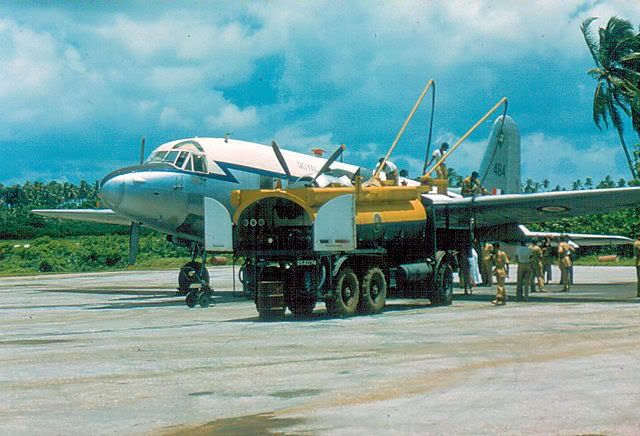
Did you ever see the famed "green flash" at sundown, btw ?
As regards Indian Ocean airstrips the Nicobar Islands has/had an airstrip at Car Nicobar. Car Nic was a regular refuelling stop for the Changi-based 'Pigs' (Valettas) and RNZAF Bristol Freighters employed on the regular Changi – Negombo (Katunayake, Sri Lanka) run. They routed Changi – RAAF Butterworth (Penang) – Car Nicobar – Negombo, and later when the crushed coral runway had been constructed at Gan, continued down there as part of the Negombo – Gan airbridge, when the frequency was upped to three a week.
I went through Car Nic a few times in 1956 – 1958, refuelling was done by the locally-based Indian Air Force personnel. There was no terminal as such and on arrival pax disembarked and just hung around the aircraft to stretch their legs whilst it was being refuelled, as in the photo below. Once refuelled we were off again ASAP.

Last edited by Warmtoast; 16th Apr 2016 at 09:56.
Guest
Posts: n/a
Warmtoast (#27),
True, but why not a woven palm leaf thatch like the Post Office ? Only snag with those, as I recall, was the insect population which dwelt in them, and flopped down from time to time!
Danny.
...They were enormously hot during the day with the heat of the sun radiating off the bare corrugated iron roof (which made a terrible din when it rained), but it was luxury compared to living in a brown tent...
Danny.
Guest
Posts: n/a
Warmtoast,
It seems to me (and no doubt to others) that this is such a magnificent photographic archive of the RAF's early days in Gan, that besides eventually lodging it with the RAF Museum and/or the IWM, it deserves in the meantime to be offered to a larger readership.
Knowing nothing about the business, or the protocol, I would hazard a guess that the National Geographic Magazine might be very interested. Nobody could argue that the Copyright is not yours.
Just a suggestion, WT, Sir,
Danny.
It seems to me (and no doubt to others) that this is such a magnificent photographic archive of the RAF's early days in Gan, that besides eventually lodging it with the RAF Museum and/or the IWM, it deserves in the meantime to be offered to a larger readership.
Knowing nothing about the business, or the protocol, I would hazard a guess that the National Geographic Magazine might be very interested. Nobody could argue that the Copyright is not yours.
Just a suggestion, WT, Sir,
Danny.
Thread Starter
Danny
Thanks for the kind words. I'll be sending a copy to the RAF Museum and seek their views as to whether further dissemination is an option.
As regards having a woven roof rather than a corrugated iron one on the new temporary accommodation blocks (your #30), I think the contractors had imported enough corrugated iron to build a small town and stuck to the plan to roof with iron, which was probably quicker and easier.
WT
Thanks for the kind words. I'll be sending a copy to the RAF Museum and seek their views as to whether further dissemination is an option.
As regards having a woven roof rather than a corrugated iron one on the new temporary accommodation blocks (your #30), I think the contractors had imported enough corrugated iron to build a small town and stuck to the plan to roof with iron, which was probably quicker and easier.
WT
Thread Starter
Continued - Part 6
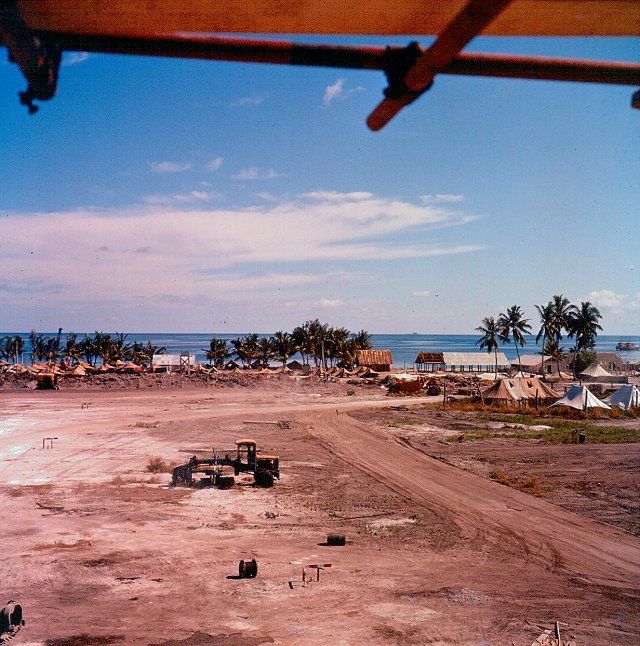
As the bulldozers and earth-movers cleared the trees and scrub, Costains the main contractors built a 'batch plant' to crush the coral and sand dredged from the lagoon into aggregate to be mixed with cement to make tons of concrete daily (below).
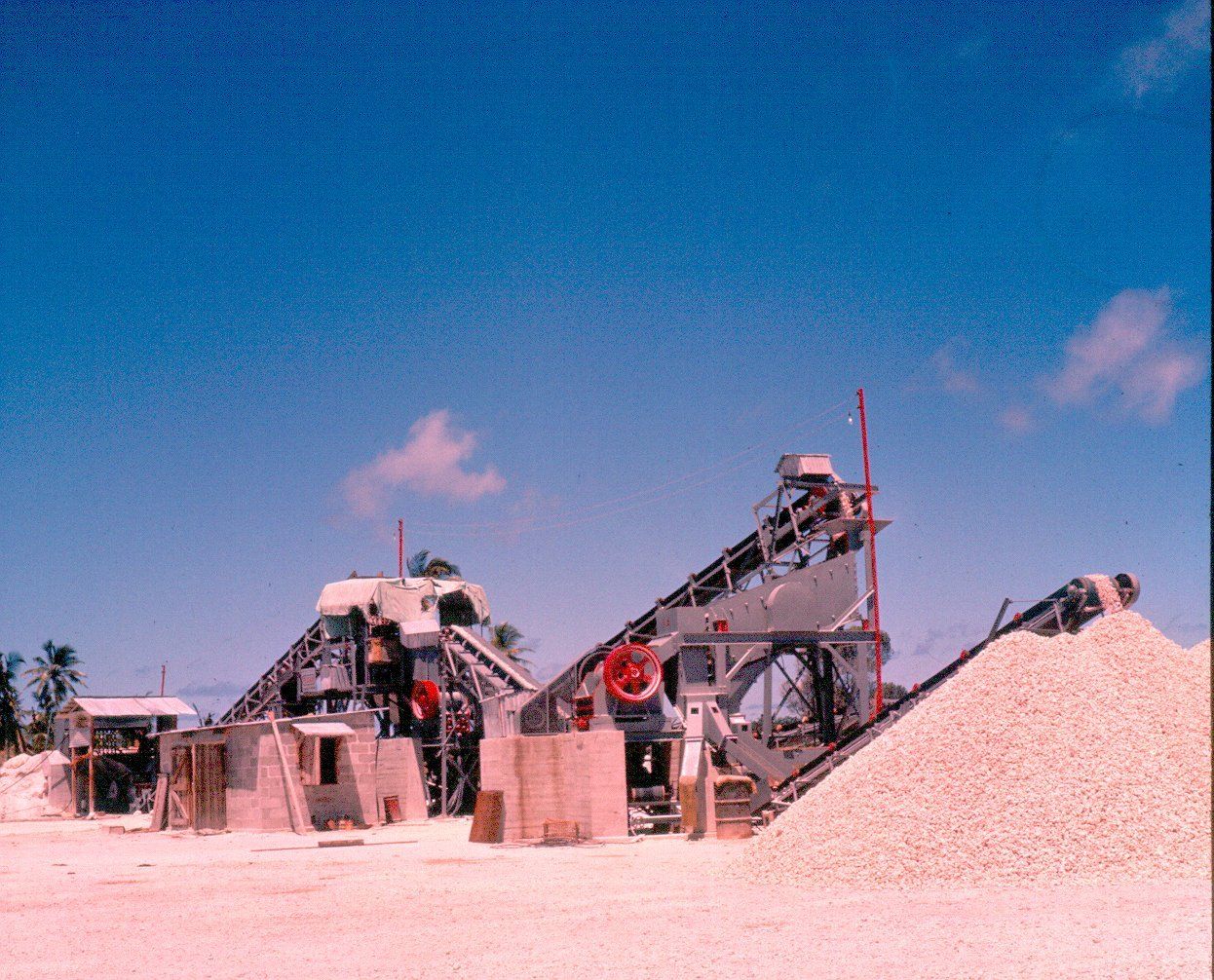
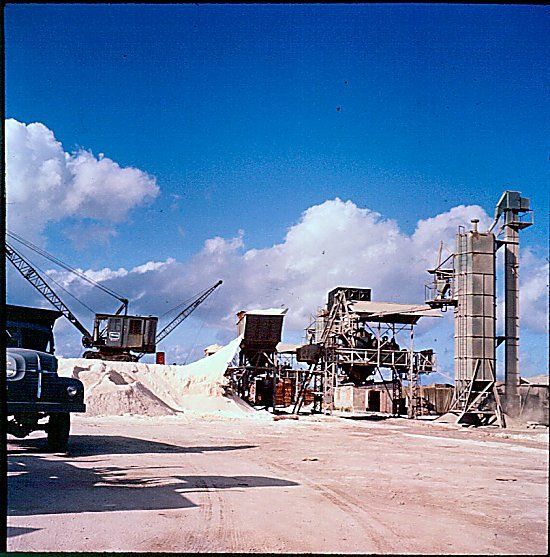

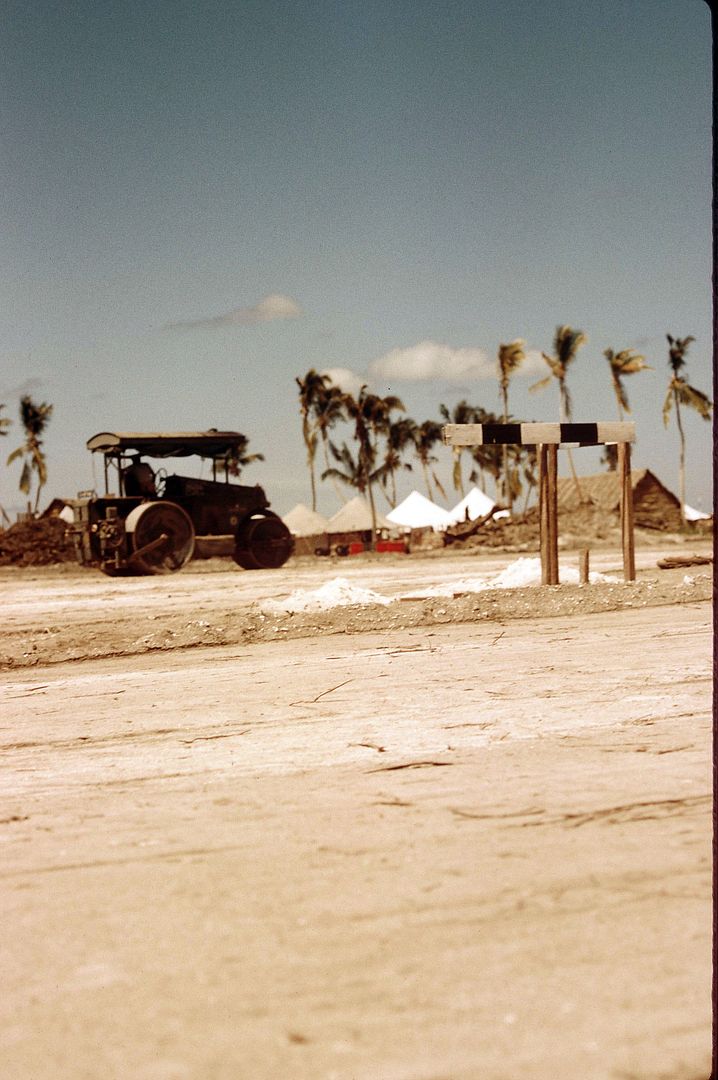
Construction proceeded apace with the laying down and concreting of the runway and aircraft parking area.


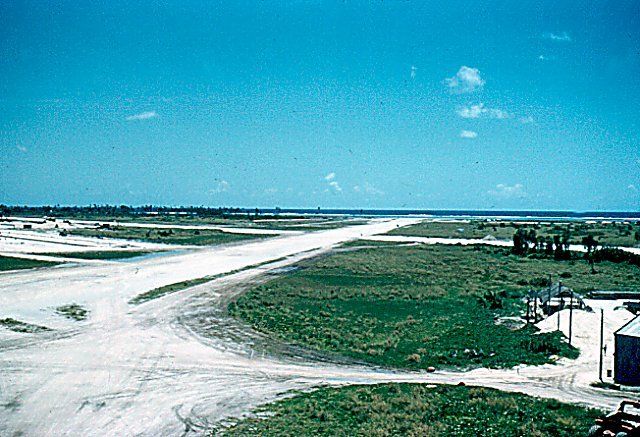
The new runway takes shape.
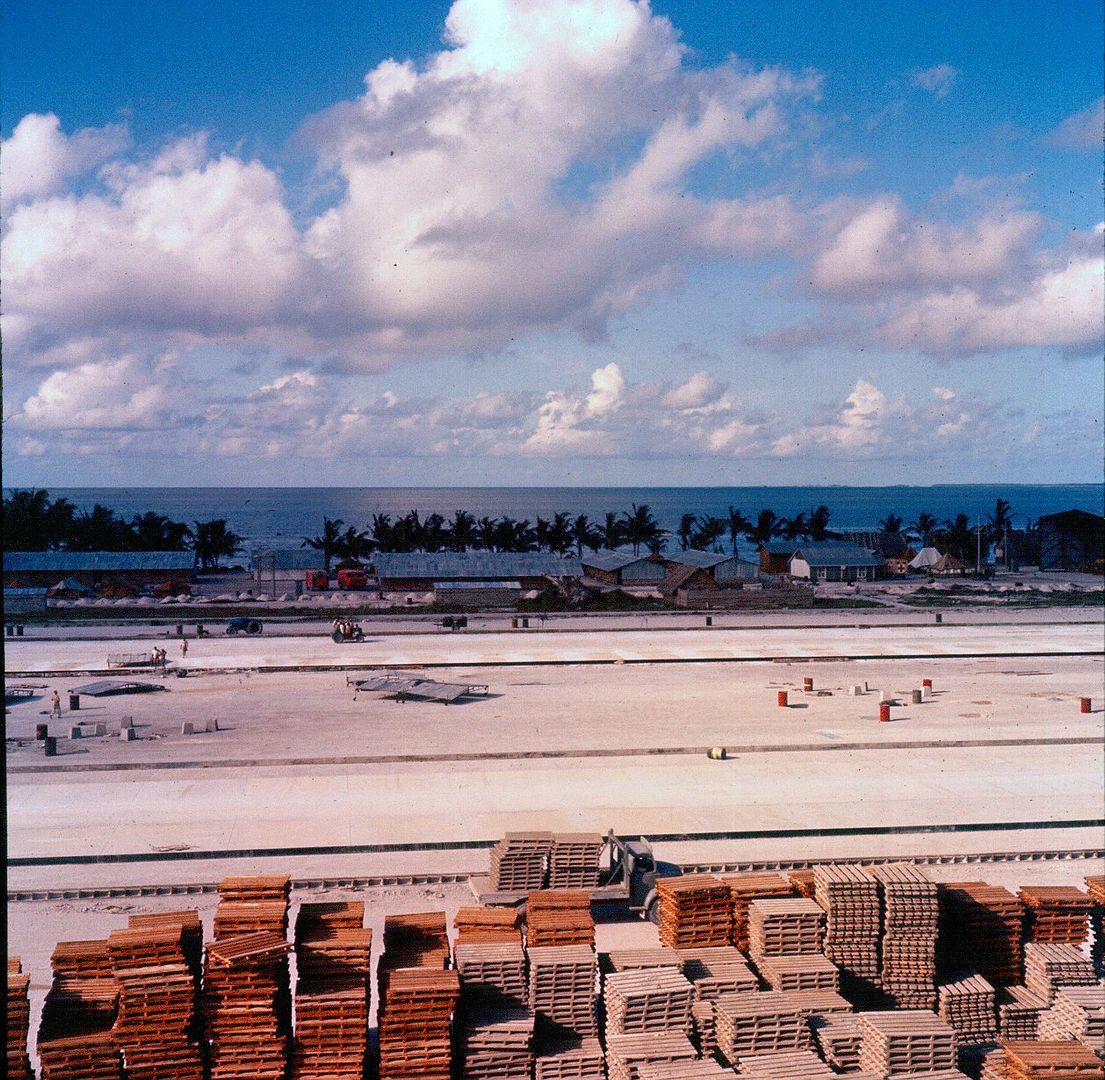
I took this photo from the top of the temporary 'batch plant' (see above). This view from the top shows the cleared aircraft parking area being laid with concrete. The wooden palettes were originally laden with the hundreds (thousands?) of tons of cement required to make the concrete.
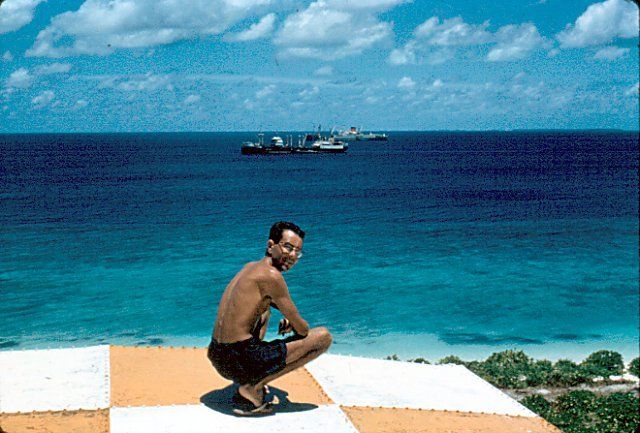
Meanwhile, a permanent water tower had been built and this shows me admiring the view from the top.
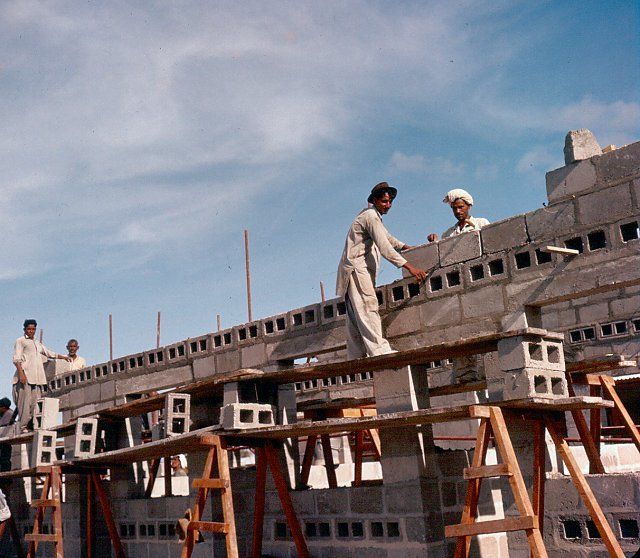
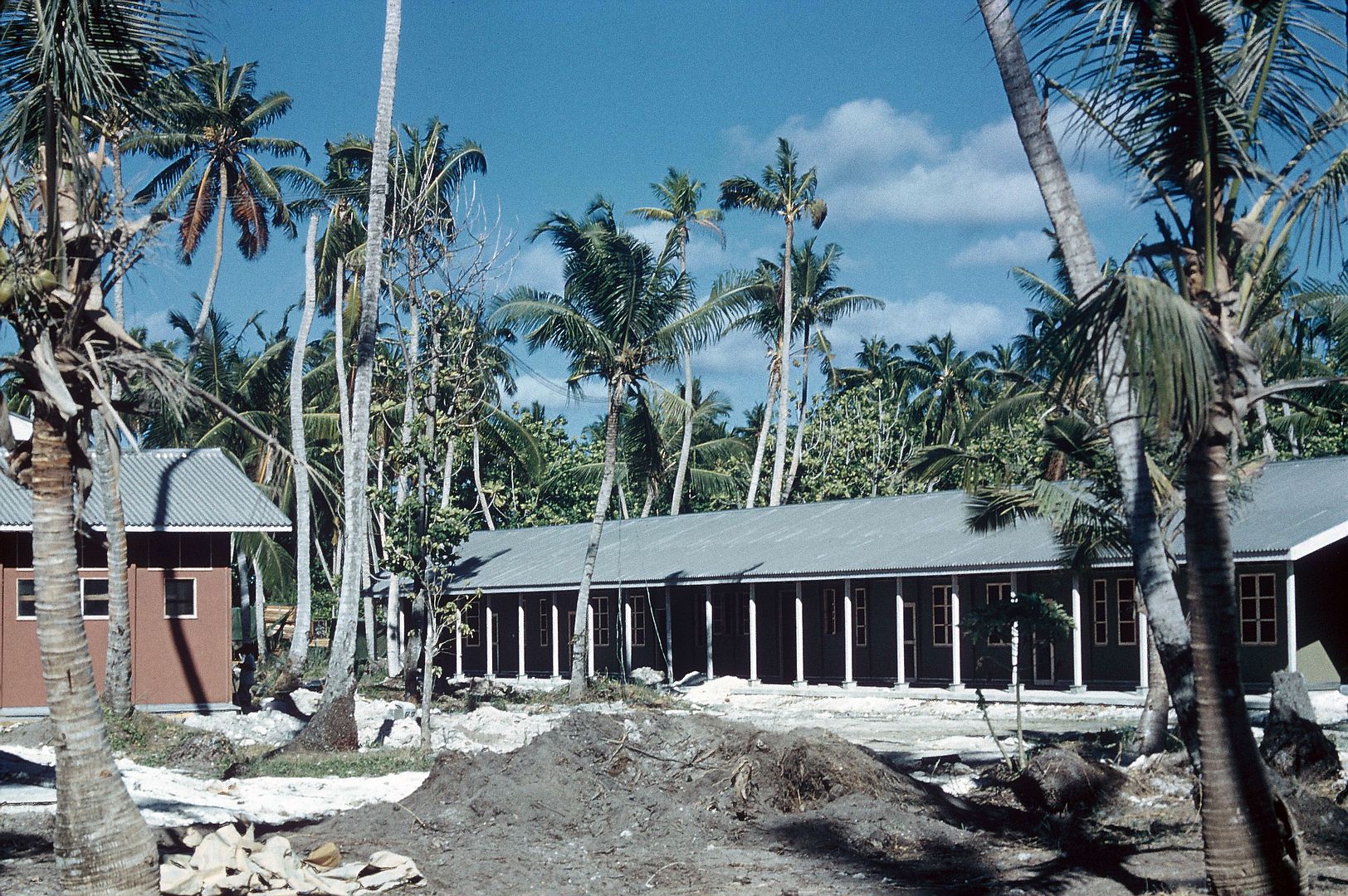
Pakistani building workers hard at work building the new permanent accommodation blocks.
First Jet to Visit Gan — 12th March 1958
12th March 1958: A Photo Reconnaissance Canberra (PR7) jet of 58 Sqn from RAF Wyton, temporarily based in Singapore and detached to RAF Negombo (Katunayake), Ceylon (Sri Lanka) took survey photos of Addu Atoll on 12th March 1958, aircraft WJ815, Pilot F/O Mudge, navigator F/O Lister. Photo runs were flown at 9,000ft. Although it didn't land this was the first visit of a jet to Gan. The mission report stated that one camera was unserviceable. Survey photos are “© Crown Copyright/MOD”.
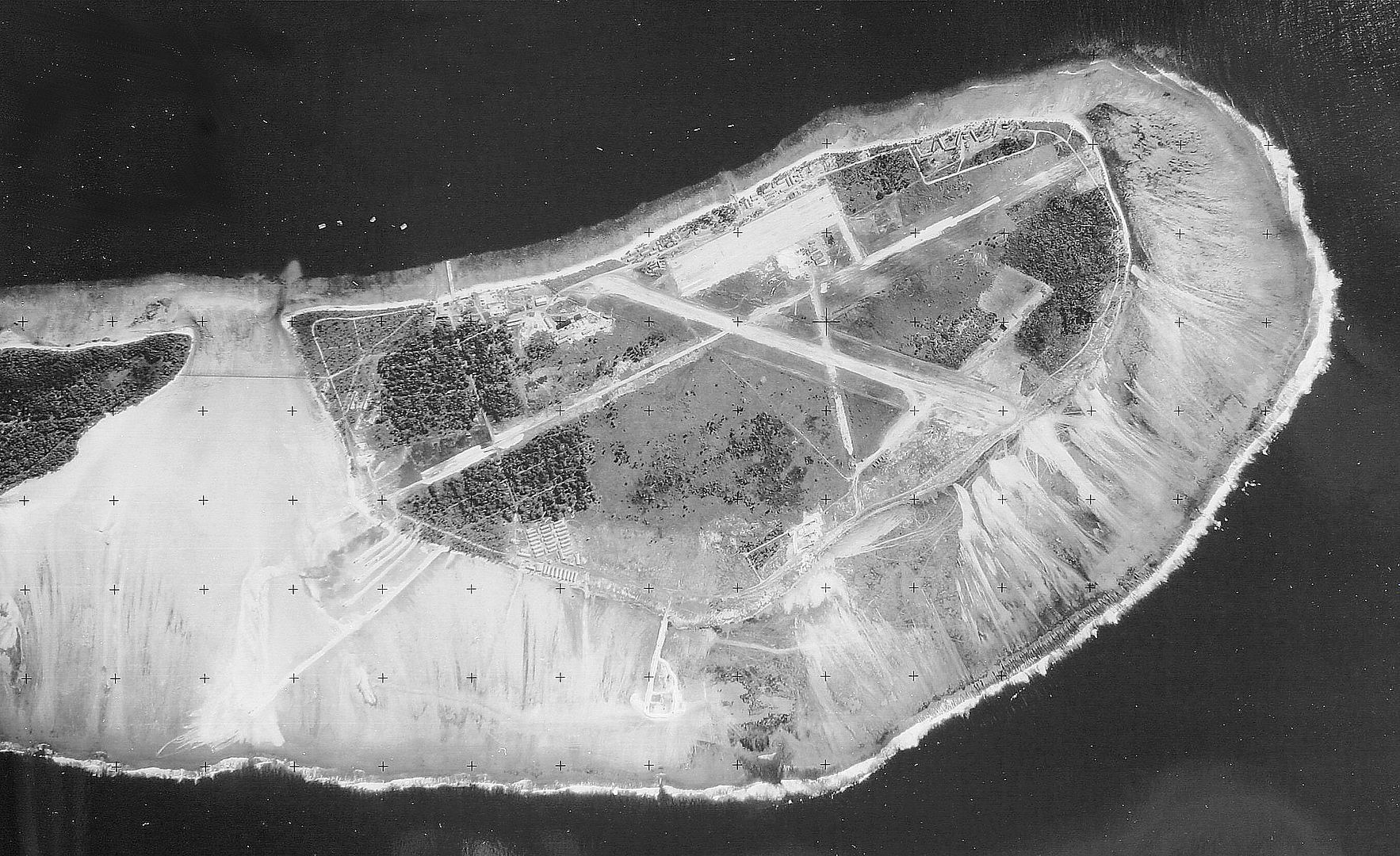
12th March 1958, survey photo of the full island. Streaks on the right between the island and outer reef show where sand and coral aggregate was dredged from the sea to make concrete for the runway etc. Photo “© Crown Copyright/MOD”

Original tented domestic site is shown including some tents still visible (to the right of the original short WW2 jetty). New buildings are shown too. Concrete laying machinery is at work on the future aircraft parking area / dispersal. Photo “© Crown Copyright/MOD”.
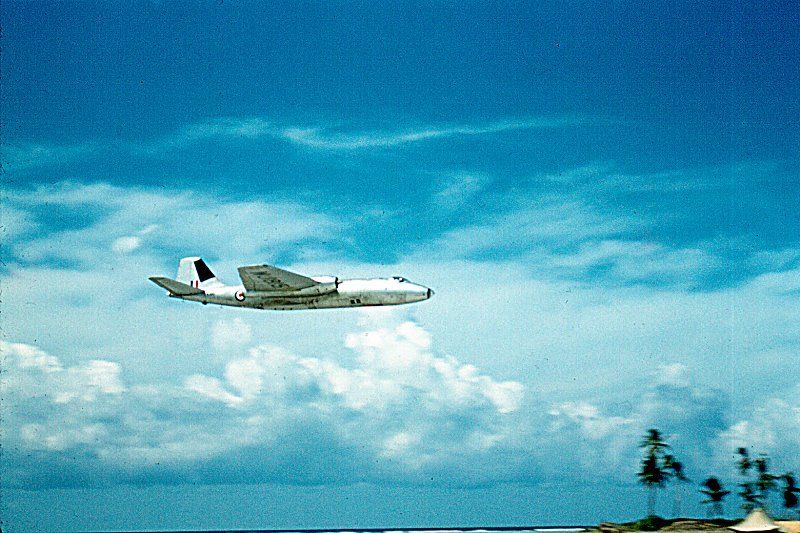
This is the 58 Squadron photo reconnaissance (PR7) Canberra that took the survey photos above. After he’d flown his survey runs at 9,000ft we asked the pilot to do a low fly-past for our cameras, which he did as seen here.
More to come
WT
As the bulldozers and earth-movers cleared the trees and scrub, Costains the main contractors built a 'batch plant' to crush the coral and sand dredged from the lagoon into aggregate to be mixed with cement to make tons of concrete daily (below).




Construction proceeded apace with the laying down and concreting of the runway and aircraft parking area.



The new runway takes shape.

I took this photo from the top of the temporary 'batch plant' (see above). This view from the top shows the cleared aircraft parking area being laid with concrete. The wooden palettes were originally laden with the hundreds (thousands?) of tons of cement required to make the concrete.

Meanwhile, a permanent water tower had been built and this shows me admiring the view from the top.

Pakistani building workers hard at work building the new permanent accommodation blocks.
First Jet to Visit Gan — 12th March 1958
12th March 1958: A Photo Reconnaissance Canberra (PR7) jet of 58 Sqn from RAF Wyton, temporarily based in Singapore and detached to RAF Negombo (Katunayake), Ceylon (Sri Lanka) took survey photos of Addu Atoll on 12th March 1958, aircraft WJ815, Pilot F/O Mudge, navigator F/O Lister. Photo runs were flown at 9,000ft. Although it didn't land this was the first visit of a jet to Gan. The mission report stated that one camera was unserviceable. Survey photos are “© Crown Copyright/MOD”.

12th March 1958, survey photo of the full island. Streaks on the right between the island and outer reef show where sand and coral aggregate was dredged from the sea to make concrete for the runway etc. Photo “© Crown Copyright/MOD”

Original tented domestic site is shown including some tents still visible (to the right of the original short WW2 jetty). New buildings are shown too. Concrete laying machinery is at work on the future aircraft parking area / dispersal. Photo “© Crown Copyright/MOD”.

This is the 58 Squadron photo reconnaissance (PR7) Canberra that took the survey photos above. After he’d flown his survey runs at 9,000ft we asked the pilot to do a low fly-past for our cameras, which he did as seen here.
More to come
WT
Last edited by Warmtoast; 15th Apr 2016 at 11:40.
Thread Starter
Continued Part 7
Air Marshal the Earl of Bandon the C-in-C Far East Air Force made his first visit to Gan in May 1958. He’d been appointed C-in-C FEAF on 13th July 1957.
An inspirational leader he was a good listener and never one for ‘officialdom’ and in the evening visited us in the Mess for a beer. He insisted on talking to us without other officers being present and asked what, if any, complaints we had. The main one raised was “why were Gan personnel were not being permitted to take advantage of the R & R indulgence flights to Singapore as laid down in R.A.F. (FEAF) Orders?” Personnel in Ceylon could do so, but those stationed at Gan seemed to have been overlooked.
He said he’d look into the matter on his return. He was PDQ because about two weeks later our complaints were answered and indulgence flights to Ceylon and onwards to Singapore were available and I was one of the many who took advantage of the flights once I’d served the necessary six-months at Gan.
He also insisted on visiting us in our various sections to see how we worked, which included a morning with the Marine Craft unit travelling out to the cargo ships at anchor in the lagoon to study close-up how the MCU coped with off-loading sometimes awkward loads from the vessels.
With this sort of attitude the C-in-C was regarded with a great deal of affection by the men under his command. He was commonly known as “The Abandoned Earl”, or if you really knew him well as “Paddy”.
On another occasion as C-in-C FEAF he opened a new service swimming pool by jumping in fully clothed to declare it open!
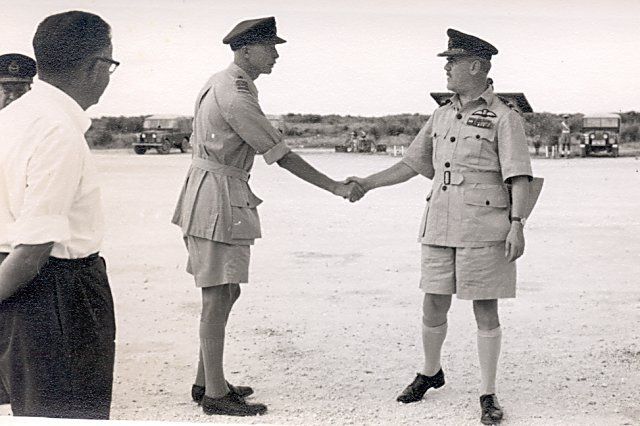
Wing Commander Kent, Commanding Officer RAF Gan, is shown here greeting the C-in-C Far East Air Force, Air Marshal the Earl of Bandon on his first visit to Gan in May 1958.
Wg. Cdr Kent took over from Squadron Leader Roy Schofield as commanding officer of R.A.F. Gan in early 1958.
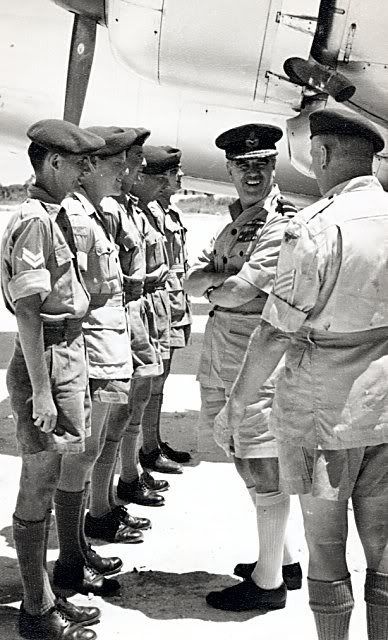
The C-in-C inspects the ground crew (under the command of Sgt Henry Moon) on his arrival.
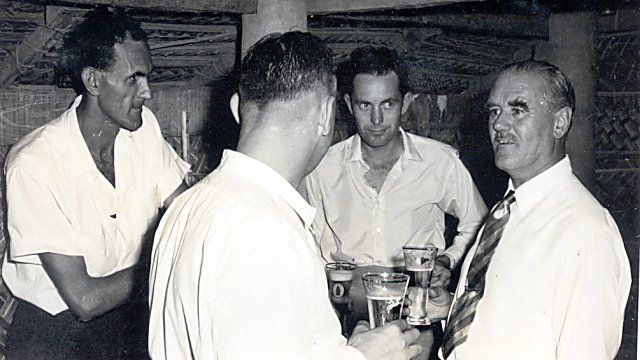
The C-in-C meets his men over a beer. A good listener and never one for ‘officialdom’ he sorted out PDQ complaints that Gan personnel were not being allowed to take leave flights to Singapore as allowed by FEAF Orders.

About this time the Marine Craft Unit took delivery of a new pinnace — ideal for trips to Villingili (below).

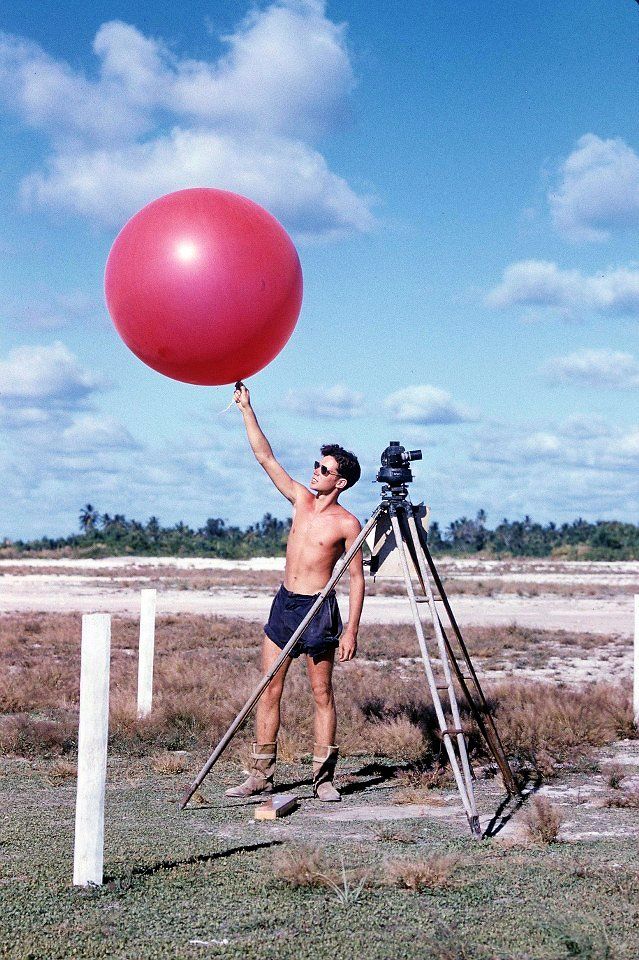
Meteorological Assistant with his balloon for measuring upper winds. It was once tracked to 20,000ft by the theodolite shown below.

About the middle of the year a professional air traffic controller was posted in and in consequence R.A.F. Gan needed its own meteorological assistant who took hourly weather readings and measured the strength and direction of upper winds twice daily with a hydrogen-filled balloon which was tracked with the aid of the theodolite shown.
The readings were passed regularly to the regional weather centre at RAF Katunayake (Negombo) in Sri Lanka for incorporation in their weather forecasts.
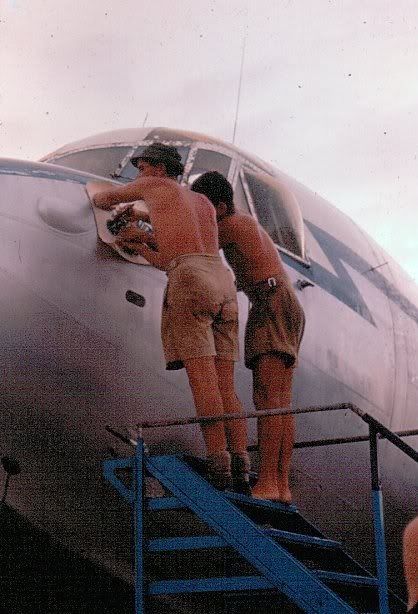
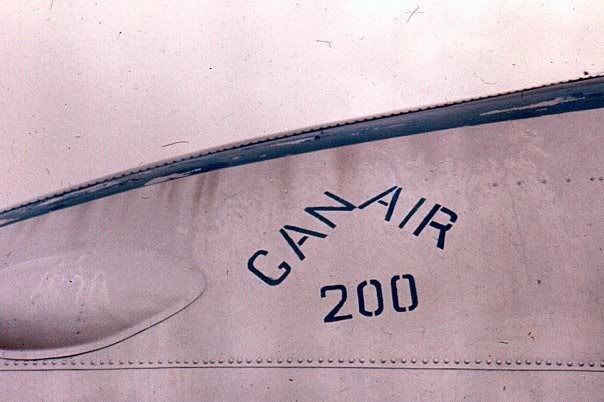
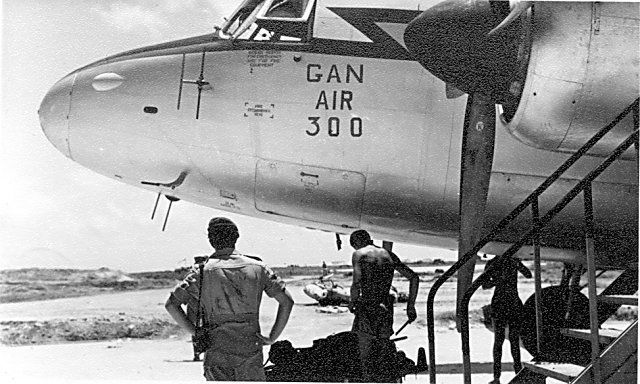
The aircraft servicing staff were in the habit of defacing the Valettas once they'd reached a significant milestone in the number of flights flown into the island. As seen here they commemorated the 200th and 300th flights appropriately.
WILDLIFE
Only a few species come to mind: Fairy Terns are delightful delicate birds, but numbers declined as the trees were destroyed. Similarly with Flying Foxes (Fruit Bats), both species moved away to other islands as their Gan habitat was destroyed. The only other creatures of note were Palm Beetles — Rhinoceros beetles we called them because of the prominent protuberance on its head that resembled the horn of a rhinoceros. They were nocturnal and attracted to bright lights and the first one knew of their presence was when they thumped into a light bulb and came crashing down — reputedly their mandibles could give a painful nip if your finger touched them, so we treated them with some respect and kept our fingers away from their head if we picked them up.
Land crabs was another creature that infested the island, they looked like marine hermit crabs, but scuttling around and thriving on scraps they found on dry land.
Finally the lagoon teemed with fish of all sorts, from sharks, moray eels down to colourful butterfly fish, but these could only be appreciated when one went swimming with a mask over the coral.
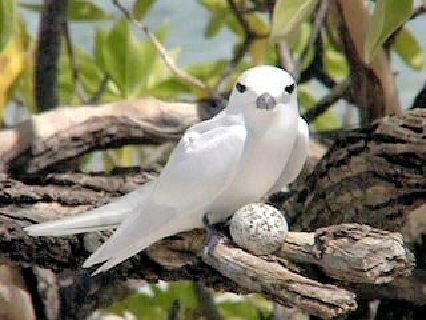
Fairy Terns lay their eggs on the branches of a tree — no nest!

Chicks are dowdy to start with as seen here, but soon develop the beautiful white plumage which makes them such a delight as they flew among the palm trees.

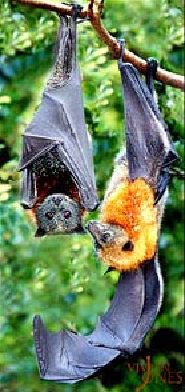
Fruit bats (Flying foxes). They were everywhere, flapping amongst the palms.
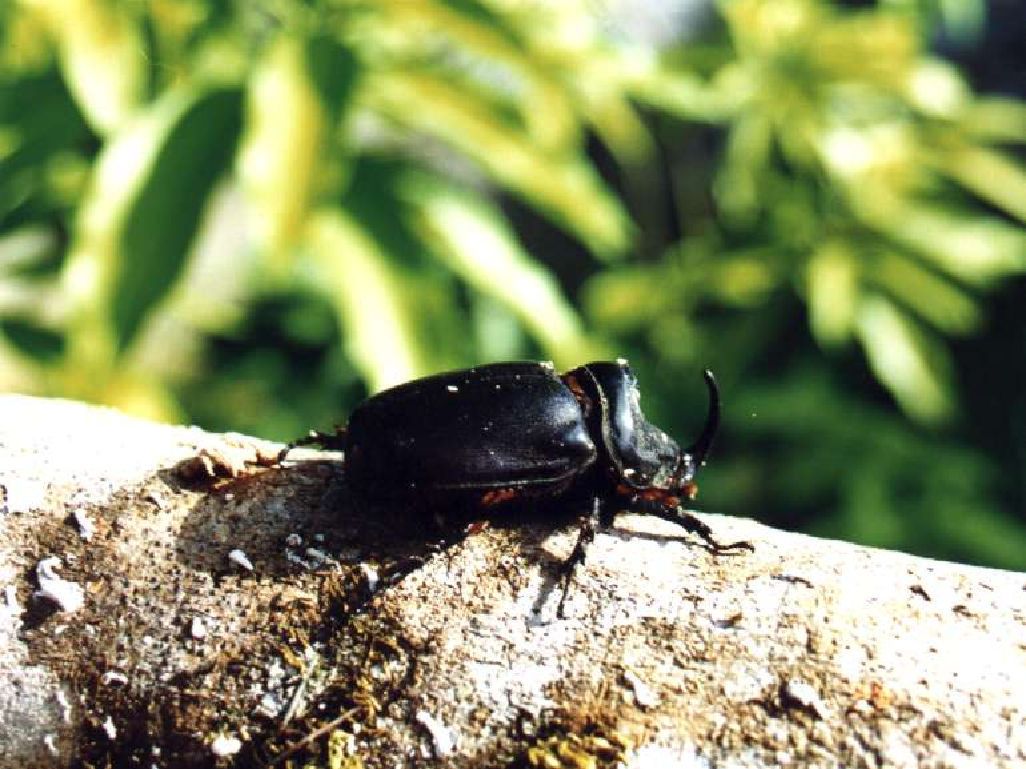
Palm Beetles — Rhinoceros beetle. Large nocturnal beetles (2-3 ins long), and attracted to bright lights. The first one knew of their presence was when they thumped into a light bulb and came crashing down — reputedly their mandibles could give a painful nip if your finger touched them, so we treated them with some respect and kept our fingers away from their head if we picked them up.
Air Marshal the Earl of Bandon the C-in-C Far East Air Force made his first visit to Gan in May 1958. He’d been appointed C-in-C FEAF on 13th July 1957.
An inspirational leader he was a good listener and never one for ‘officialdom’ and in the evening visited us in the Mess for a beer. He insisted on talking to us without other officers being present and asked what, if any, complaints we had. The main one raised was “why were Gan personnel were not being permitted to take advantage of the R & R indulgence flights to Singapore as laid down in R.A.F. (FEAF) Orders?” Personnel in Ceylon could do so, but those stationed at Gan seemed to have been overlooked.
He said he’d look into the matter on his return. He was PDQ because about two weeks later our complaints were answered and indulgence flights to Ceylon and onwards to Singapore were available and I was one of the many who took advantage of the flights once I’d served the necessary six-months at Gan.
He also insisted on visiting us in our various sections to see how we worked, which included a morning with the Marine Craft unit travelling out to the cargo ships at anchor in the lagoon to study close-up how the MCU coped with off-loading sometimes awkward loads from the vessels.
With this sort of attitude the C-in-C was regarded with a great deal of affection by the men under his command. He was commonly known as “The Abandoned Earl”, or if you really knew him well as “Paddy”.
On another occasion as C-in-C FEAF he opened a new service swimming pool by jumping in fully clothed to declare it open!

Wing Commander Kent, Commanding Officer RAF Gan, is shown here greeting the C-in-C Far East Air Force, Air Marshal the Earl of Bandon on his first visit to Gan in May 1958.
Wg. Cdr Kent took over from Squadron Leader Roy Schofield as commanding officer of R.A.F. Gan in early 1958.

The C-in-C inspects the ground crew (under the command of Sgt Henry Moon) on his arrival.

The C-in-C meets his men over a beer. A good listener and never one for ‘officialdom’ he sorted out PDQ complaints that Gan personnel were not being allowed to take leave flights to Singapore as allowed by FEAF Orders.

About this time the Marine Craft Unit took delivery of a new pinnace — ideal for trips to Villingili (below).


Meteorological Assistant with his balloon for measuring upper winds. It was once tracked to 20,000ft by the theodolite shown below.

About the middle of the year a professional air traffic controller was posted in and in consequence R.A.F. Gan needed its own meteorological assistant who took hourly weather readings and measured the strength and direction of upper winds twice daily with a hydrogen-filled balloon which was tracked with the aid of the theodolite shown.
The readings were passed regularly to the regional weather centre at RAF Katunayake (Negombo) in Sri Lanka for incorporation in their weather forecasts.



The aircraft servicing staff were in the habit of defacing the Valettas once they'd reached a significant milestone in the number of flights flown into the island. As seen here they commemorated the 200th and 300th flights appropriately.
WILDLIFE
Only a few species come to mind: Fairy Terns are delightful delicate birds, but numbers declined as the trees were destroyed. Similarly with Flying Foxes (Fruit Bats), both species moved away to other islands as their Gan habitat was destroyed. The only other creatures of note were Palm Beetles — Rhinoceros beetles we called them because of the prominent protuberance on its head that resembled the horn of a rhinoceros. They were nocturnal and attracted to bright lights and the first one knew of their presence was when they thumped into a light bulb and came crashing down — reputedly their mandibles could give a painful nip if your finger touched them, so we treated them with some respect and kept our fingers away from their head if we picked them up.
Land crabs was another creature that infested the island, they looked like marine hermit crabs, but scuttling around and thriving on scraps they found on dry land.
Finally the lagoon teemed with fish of all sorts, from sharks, moray eels down to colourful butterfly fish, but these could only be appreciated when one went swimming with a mask over the coral.

Fairy Terns lay their eggs on the branches of a tree — no nest!

Chicks are dowdy to start with as seen here, but soon develop the beautiful white plumage which makes them such a delight as they flew among the palm trees.


Fruit bats (Flying foxes). They were everywhere, flapping amongst the palms.

Palm Beetles — Rhinoceros beetle. Large nocturnal beetles (2-3 ins long), and attracted to bright lights. The first one knew of their presence was when they thumped into a light bulb and came crashing down — reputedly their mandibles could give a painful nip if your finger touched them, so we treated them with some respect and kept our fingers away from their head if we picked them up.
Last edited by Warmtoast; 16th Apr 2016 at 21:07.
Guest
Posts: n/a
Warmtoast,
Just what we needed as an ASR vessel at Cannanore (instead of the Bomb Scow I was offered ! Full story in "Pilot's Brevet" Page 162 # 3222).
We had "Paddy" Bandon as one of our AOCs (221 Gp) in Burma. The stories surrounding him are legion.
Danny.
...About this time the Marine Craft Unit took delivery of a new pinnace...
We had "Paddy" Bandon as one of our AOCs (221 Gp) in Burma. The stories surrounding him are legion.
Danny.
Last edited by Danny42C; 16th Apr 2016 at 21:24. Reason: ADDN.
Thread Starter
Continued - Part 8
Leisure & Spare Time Activities
We swam a lot, explored the other islands, had our own football team and personally I was very involved with Amateur Radio as a “HAM” Radio Operator. Being a keen swimmer I was attracted to Gan’s brilliantly clear turquoise water and the coral heads just below the water that teemed with a large variety of brilliantly-coloured fish. Among others Moray eels and the occasional grey reef shark that patrolled the edge of the reef could be seen. Having been primed by advice from Dr Hans Hass that when swimming/diving off the edge of the reef to always carry a broomstick with a sharpened nail at the end to protect oneself from inquisitive sharks — a poke from this would deter most sharks that came too close, or so Dr Hass claimed.
I tried spear fishing and caught a variety of fish that I took along to the cook-house, the cooks particularly appreciated a large Grouper or two which they would cook for our supper. Groupers are large and heavy bottom feeders and easy to spear, but one had to dive deep to spear them and as they were large fish one had to struggle to get them ashore.
According to Dr Hass there was one problem with speared fish — they struggle and their frantic struggling sent out vibrations detectable by nearby sharks that came homing in to the struggling fish as a potential free meal; the danger was that the spear fisherman (me) would be viewed by the shark as a potential free meal too! So one kept a good lookout whilst spear fishing and dragged a struggling speared fish over the reef into the relative safety of the shallows as soon as possible before despatching it with a blow to the head.
Fishing with rods was also popular with the easy to catch land crabs proving to be ideal bait on the hooks.
Visiting other islands was interesting and Fedu in particular was popular as we could, like the locals, wade across to the island. However, Hittadu, the site of the future Signals Centre was further away, and only reachable by the R.A.F. motor pinnace or by sail in a local dhoni.
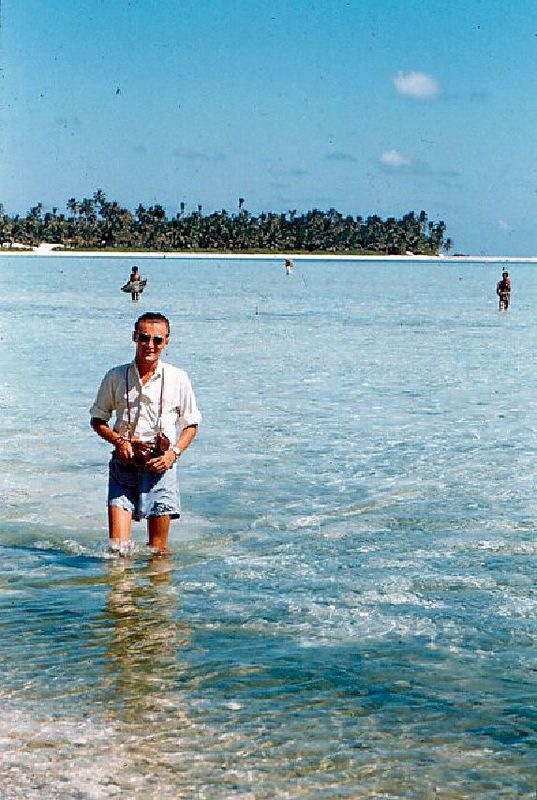
Visiting Fedu.
As the Gan - Fedu causeway had deteriorated (wooden planking had been removed by the locals and used as firewood following the departure of the RAF after WWII), the only way across was by wading as seen here. This was standard practice for the locals living at Fedu who worked at Gan and they too can be seen in this photo.

Swimming was gorgeous
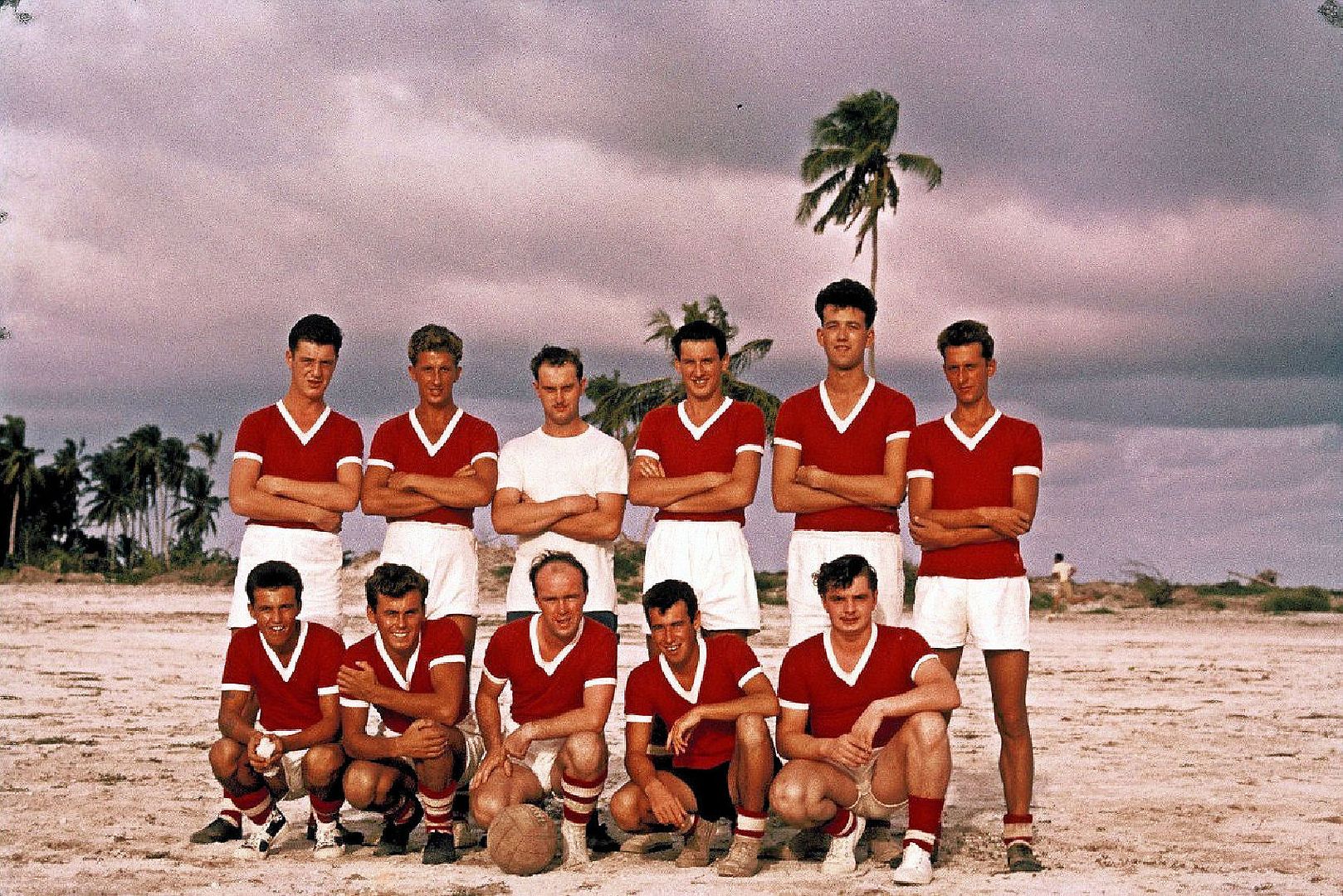
We had our own football team and played against teams from visiting ships and sometimes teams were flown in from Katunayake (Negombo) and elsewhere
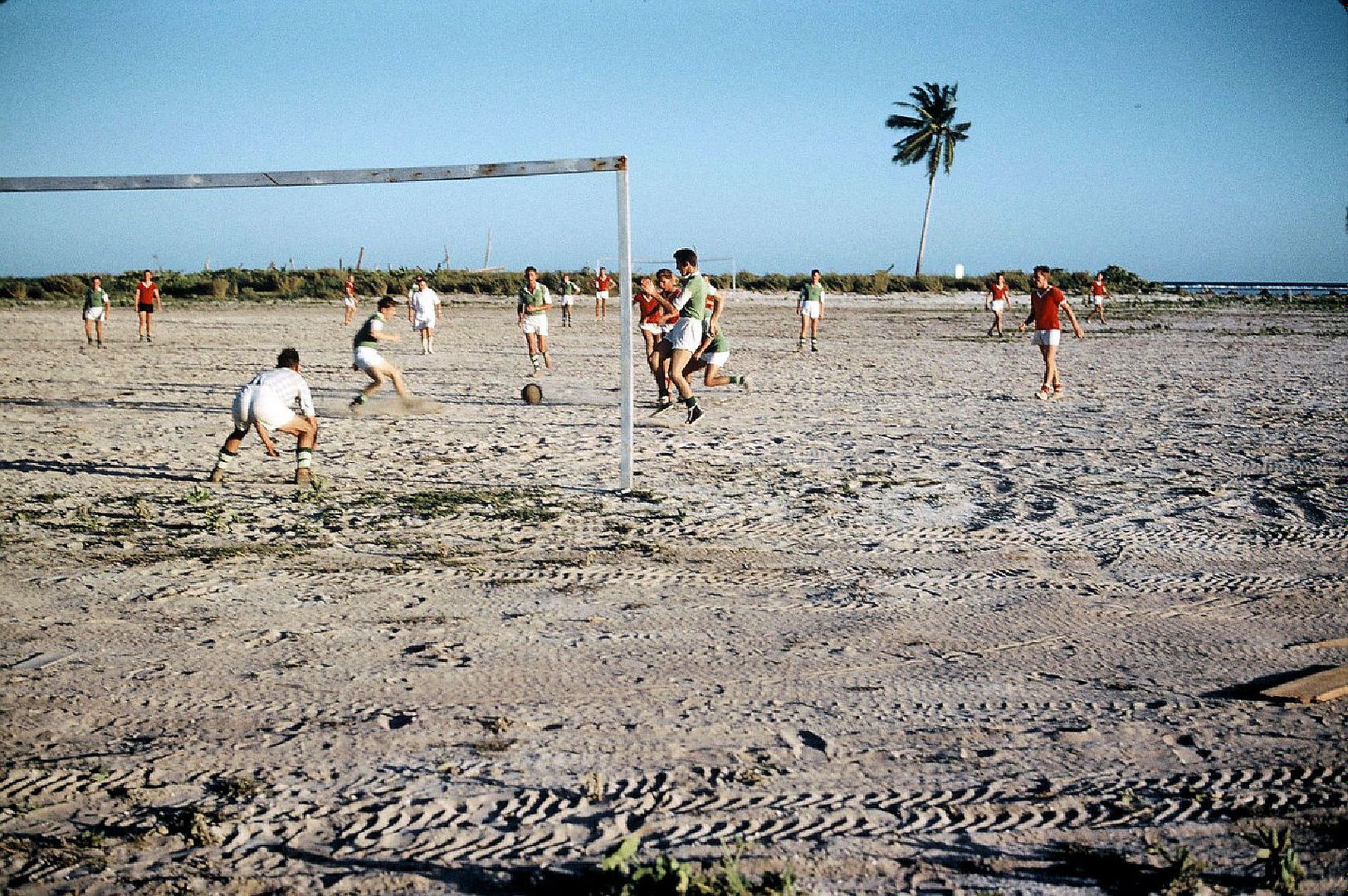
The pitch was coral sand, not ideal but OK

Visits to other islands in the atoll such as Villingili (below) were possible using the R.A.F. Pinnace

Villingili
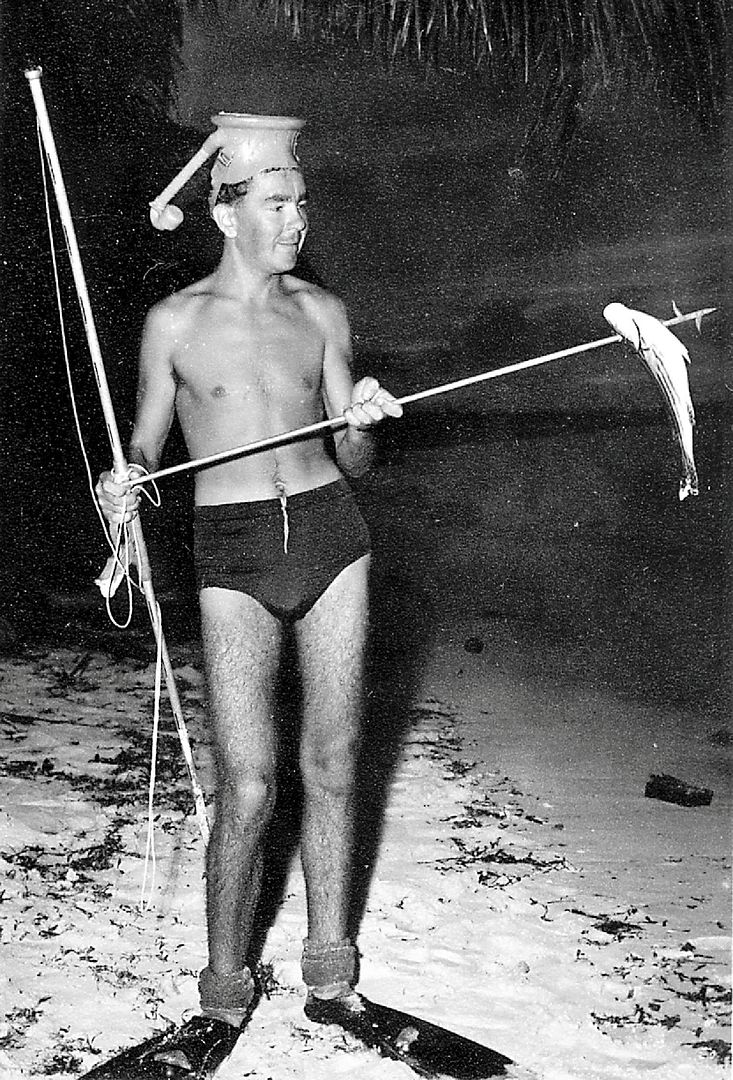
I tried spear fishing and caught a variety of fish (this one was not one of the more desirable and edible Groupers mentioned above)
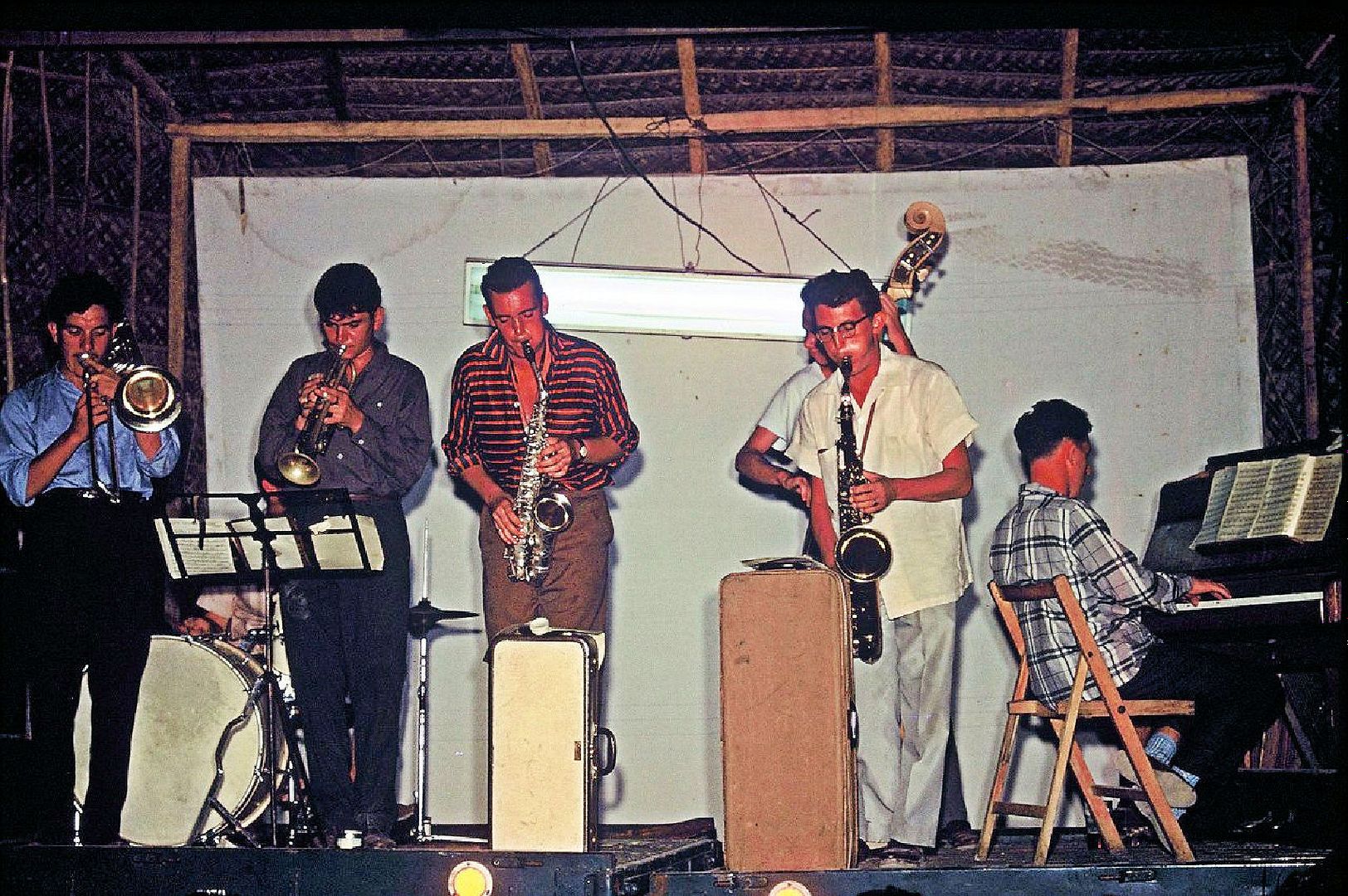
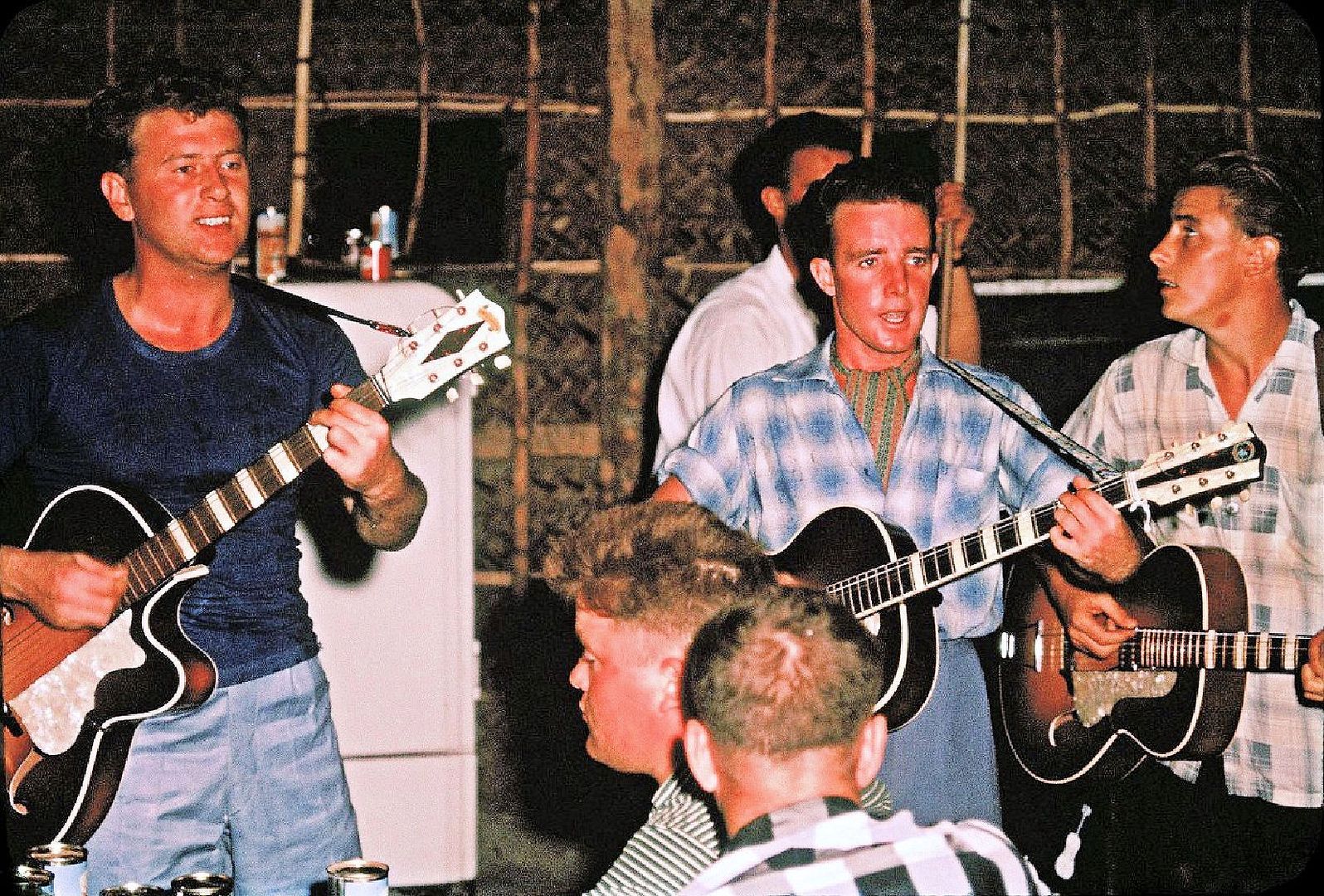
Personnel stationed at Gan in the early days had a variety of talents that they used to entertain us as seen here in front of the outdoor cinema screen, the piano was supplied by the R.A.F., but who supplied the drum kit I have no idea.
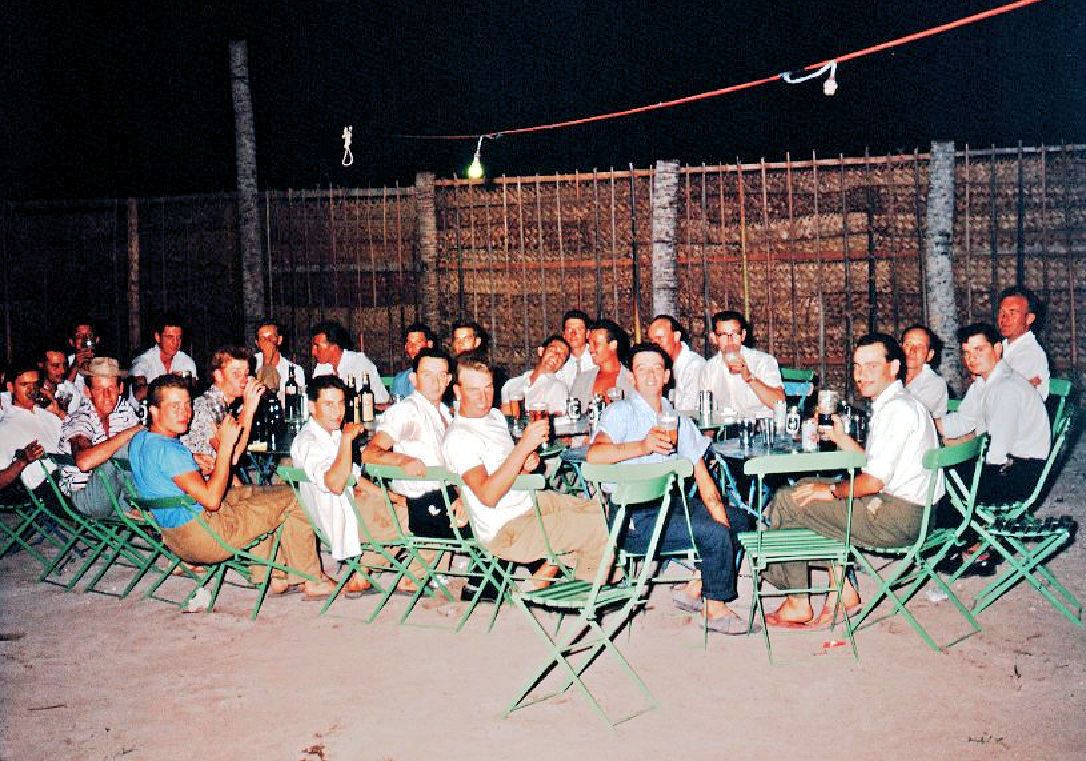
Farewell parties when someone returned home to the UK could be pretty lively events with way too much drink being consumed as seen here at my farewell party in November 1958.

The interior of our kadjan-walled barrack hut with colleagues from the Signals Section
Leisure & Spare Time Activities
We swam a lot, explored the other islands, had our own football team and personally I was very involved with Amateur Radio as a “HAM” Radio Operator. Being a keen swimmer I was attracted to Gan’s brilliantly clear turquoise water and the coral heads just below the water that teemed with a large variety of brilliantly-coloured fish. Among others Moray eels and the occasional grey reef shark that patrolled the edge of the reef could be seen. Having been primed by advice from Dr Hans Hass that when swimming/diving off the edge of the reef to always carry a broomstick with a sharpened nail at the end to protect oneself from inquisitive sharks — a poke from this would deter most sharks that came too close, or so Dr Hass claimed.
I tried spear fishing and caught a variety of fish that I took along to the cook-house, the cooks particularly appreciated a large Grouper or two which they would cook for our supper. Groupers are large and heavy bottom feeders and easy to spear, but one had to dive deep to spear them and as they were large fish one had to struggle to get them ashore.
According to Dr Hass there was one problem with speared fish — they struggle and their frantic struggling sent out vibrations detectable by nearby sharks that came homing in to the struggling fish as a potential free meal; the danger was that the spear fisherman (me) would be viewed by the shark as a potential free meal too! So one kept a good lookout whilst spear fishing and dragged a struggling speared fish over the reef into the relative safety of the shallows as soon as possible before despatching it with a blow to the head.
Fishing with rods was also popular with the easy to catch land crabs proving to be ideal bait on the hooks.
Visiting other islands was interesting and Fedu in particular was popular as we could, like the locals, wade across to the island. However, Hittadu, the site of the future Signals Centre was further away, and only reachable by the R.A.F. motor pinnace or by sail in a local dhoni.

Visiting Fedu.
As the Gan - Fedu causeway had deteriorated (wooden planking had been removed by the locals and used as firewood following the departure of the RAF after WWII), the only way across was by wading as seen here. This was standard practice for the locals living at Fedu who worked at Gan and they too can be seen in this photo.

Swimming was gorgeous

We had our own football team and played against teams from visiting ships and sometimes teams were flown in from Katunayake (Negombo) and elsewhere

The pitch was coral sand, not ideal but OK

Visits to other islands in the atoll such as Villingili (below) were possible using the R.A.F. Pinnace

Villingili

I tried spear fishing and caught a variety of fish (this one was not one of the more desirable and edible Groupers mentioned above)


Personnel stationed at Gan in the early days had a variety of talents that they used to entertain us as seen here in front of the outdoor cinema screen, the piano was supplied by the R.A.F., but who supplied the drum kit I have no idea.

Farewell parties when someone returned home to the UK could be pretty lively events with way too much drink being consumed as seen here at my farewell party in November 1958.

The interior of our kadjan-walled barrack hut with colleagues from the Signals Section
Last edited by Warmtoast; 17th Apr 2016 at 23:04.
Warmtoast,
I seem to remember that some RAF recruiting adverts used to feature Gan as 'the RAF's own island in the sun'. Those were the days.
When the RAF pulled I was convinced some UK holiday firm would take it over.
I wonder why they did not.
I seem to remember that some RAF recruiting adverts used to feature Gan as 'the RAF's own island in the sun'. Those were the days.
When the RAF pulled I was convinced some UK holiday firm would take it over.
I wonder why they did not.
VC10 Flights through Gan
Between October 1970 and October 1973 I flew VC10s through Gan en route from Brize Norton (via Bahrain) to Singapore and Hong Kong, then home via Gan and Akrotiri. When outbound, Gan was a ninety-minute stop for refuelling with the same crew continuing eastbound, but on the way home we spent two or three days on the island.
Amongst the memories I have of these visits, the most enduring was the silence that we enjoyed in the early days when outboard engines were banned from use, meaning that the Maldivian workers rowed across the lagoon, coming to work in the morning and returning at dusk. Then, it was for me the most peaceful place on earth! Later, when permission to use outboard engines was permitted, the droning noise persisted all day long and that wonderful peace was broken.
When landing VC10s at Gan I had always to remember that the runway was narrower than almost anywhere else, and so the perspective on crossing the threshold was that we were higher above the surface than was actually the case. To forget this, meaning that the roundout was later than it should have been, resulted in a firmer touchdown (aka a hard landing) than we aimed for! Incidentally, at Brize Norton the flight simulator used a three-dimensional wall-mounted map of Gan that, coupled with a camera and associated screen, enabled pilots undergoing refresher training to practice emergencies such as engine failures on takeoff. On such occasions, the first engine would be 'failed' just after passing V1 (no longer sufficient runway on which to stop) and the second engine at Rotate, for which the speed would be achieved further towards the end of the runway than normal. The climb out would then have to be very, very gentle whilst raising the gear and flaps and jettisoning fuel down to a weight at which the pilot could begin a turn back towards the island to be followed by a two-engined landing.
On the way home, our passengers would be taken by bus to the Transit Lounge where we, the whole crew that is, would follow. Whilst they would be able to stretch their legs and get a drink, we would obtain jugs of beer and - a special treat, this - fried chickens to divide up amongst us! Some 20 minutes or so after we had reached the lounge the passengers would be called back to their buses, the new crew would be ready to receive them on board, and shortly afterwards the VC10 would roar off into the night sky. I remember one occasion when one of the passengers who knew a member of the crew joined us for our beer and chicken, and missed the call to get back on board his bus. As the aircraft took off he said words to the effect of, 'I didn't see a second VC10 on the pan: is it often as busy as this?' There was no way out until the next aircraft came through.
Also on one occasion whilst I was there a Britannia came through from Singapore. As these aircraft were slower than the 10s their crews stayed with them - and their passengers. On this occasion the passengers were all, it was said, Navy wives who were being returned home for being 'naughty' (whatever that meant). You can imagine that the presence on the island of a number of young women was greatly appreciated by those who were based there, and I understand that a great time was had by the latter. As our VC10 crews often/usually included female cabin crew, our visits to the cinema were generally very warmly welcomed!
There were only two little niggles I had about our flights through Gan. One was the insistence by our commanders in the UK that we had to wear uniforms that accorded with what the 'locals' were required to wear. This meant that we VC10 crews had to wear No 1 blue uniforms out of Brize Norton and carry tropical uniforms, both short sleeves/short trousers and long sleeves/long trousers to wear when departing en route stations. What a nonsense this was, and how heavy our luggage! The second was that in order that passengers leaving Singapore and Hong Kong could do so at an hour that suited their Air Movements personnel, we had to depart from Brize Norton at midnight. This meant that we had to check in three hours beforehand (for the Navigator to draw up his charts). Our stopover at Bahrain was 26 hours - a period that the UK CAA has said should be avoided (anything between 18 and 30 hours) - meaning that it was all but impossible to get a decent period of rest (i.e. two periods of eight hours sleep) before departing for Gan and the stations further East. On my first two flights to the Asian destinations after completing my co-pilot course, after refuelling at Gan each Captain fell asleep at the controls before reaching top-of-climb and without handing over to me. I found it a real struggle to stay awake for the four hours or so this took us to reach Singapore (RAF Changi).
It wasn't, of course, always sunny at Gan, and many of our landings were carried out in heavy rain when the blurry glow of the runway lights viewed through the windscreen was most welcome. However, it is the good things that stay foremost in mind, and I recall with pleasure the most beautiful sunsets and sunrises so often seen from Gan. Happy memories!
Amongst the memories I have of these visits, the most enduring was the silence that we enjoyed in the early days when outboard engines were banned from use, meaning that the Maldivian workers rowed across the lagoon, coming to work in the morning and returning at dusk. Then, it was for me the most peaceful place on earth! Later, when permission to use outboard engines was permitted, the droning noise persisted all day long and that wonderful peace was broken.
When landing VC10s at Gan I had always to remember that the runway was narrower than almost anywhere else, and so the perspective on crossing the threshold was that we were higher above the surface than was actually the case. To forget this, meaning that the roundout was later than it should have been, resulted in a firmer touchdown (aka a hard landing) than we aimed for! Incidentally, at Brize Norton the flight simulator used a three-dimensional wall-mounted map of Gan that, coupled with a camera and associated screen, enabled pilots undergoing refresher training to practice emergencies such as engine failures on takeoff. On such occasions, the first engine would be 'failed' just after passing V1 (no longer sufficient runway on which to stop) and the second engine at Rotate, for which the speed would be achieved further towards the end of the runway than normal. The climb out would then have to be very, very gentle whilst raising the gear and flaps and jettisoning fuel down to a weight at which the pilot could begin a turn back towards the island to be followed by a two-engined landing.
On the way home, our passengers would be taken by bus to the Transit Lounge where we, the whole crew that is, would follow. Whilst they would be able to stretch their legs and get a drink, we would obtain jugs of beer and - a special treat, this - fried chickens to divide up amongst us! Some 20 minutes or so after we had reached the lounge the passengers would be called back to their buses, the new crew would be ready to receive them on board, and shortly afterwards the VC10 would roar off into the night sky. I remember one occasion when one of the passengers who knew a member of the crew joined us for our beer and chicken, and missed the call to get back on board his bus. As the aircraft took off he said words to the effect of, 'I didn't see a second VC10 on the pan: is it often as busy as this?' There was no way out until the next aircraft came through.
Also on one occasion whilst I was there a Britannia came through from Singapore. As these aircraft were slower than the 10s their crews stayed with them - and their passengers. On this occasion the passengers were all, it was said, Navy wives who were being returned home for being 'naughty' (whatever that meant). You can imagine that the presence on the island of a number of young women was greatly appreciated by those who were based there, and I understand that a great time was had by the latter. As our VC10 crews often/usually included female cabin crew, our visits to the cinema were generally very warmly welcomed!
There were only two little niggles I had about our flights through Gan. One was the insistence by our commanders in the UK that we had to wear uniforms that accorded with what the 'locals' were required to wear. This meant that we VC10 crews had to wear No 1 blue uniforms out of Brize Norton and carry tropical uniforms, both short sleeves/short trousers and long sleeves/long trousers to wear when departing en route stations. What a nonsense this was, and how heavy our luggage! The second was that in order that passengers leaving Singapore and Hong Kong could do so at an hour that suited their Air Movements personnel, we had to depart from Brize Norton at midnight. This meant that we had to check in three hours beforehand (for the Navigator to draw up his charts). Our stopover at Bahrain was 26 hours - a period that the UK CAA has said should be avoided (anything between 18 and 30 hours) - meaning that it was all but impossible to get a decent period of rest (i.e. two periods of eight hours sleep) before departing for Gan and the stations further East. On my first two flights to the Asian destinations after completing my co-pilot course, after refuelling at Gan each Captain fell asleep at the controls before reaching top-of-climb and without handing over to me. I found it a real struggle to stay awake for the four hours or so this took us to reach Singapore (RAF Changi).
It wasn't, of course, always sunny at Gan, and many of our landings were carried out in heavy rain when the blurry glow of the runway lights viewed through the windscreen was most welcome. However, it is the good things that stay foremost in mind, and I recall with pleasure the most beautiful sunsets and sunrises so often seen from Gan. Happy memories!



